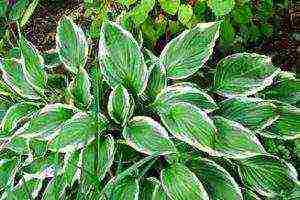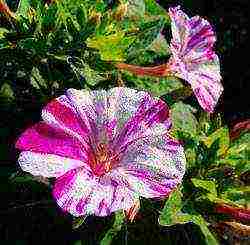Content
- 1 Curly rose: planting and care, photo
- 2 Caring for planted bushes
- 3 Features of climbing roses
- 4 Planting climbing roses in open ground
- 5 Outdoor climbing care for climbing roses
- 6 Pruning climbing roses
- 7 Reproduction of climbing roses
- 8 Features of care after flowering
- 9 Winter care
- 10 Climbing rose varieties with photos and names
Let's find out in more detail what a climbing rose is. Planting and caring for this marvelous flower in the open field will be discussed in stages in this article. Summer residents and gardeners know that with the help of this type of roses, you can turn even the most modest plot into a beautiful romantic corner.
Climbing rose - description of the type and planting features
The shoots of climbing roses can reach several meters. Any support located in close proximity to the bush is quickly braided by its long and flexible branches. You have surely admired amazingly beautiful flower arches more than once. Floral columns, pyramids, trellises, well-disguised old buildings, part of a wall or roof - any garden structure can be decorated with a luxurious climbing rose. This type of plant is ideal for vertical gardening, but in order for everything to look harmonious and attractive, you should know the rules for planting, pruning, caring for and protecting bushes from pests.
The color scheme of this type of roses is as varied as that of their park or ground cover relatives. Buds range in size from 2.5 to 12 cm in diameter, climbing rose varieties bloom in June and continue to bloom as long as the warm season lasts (approximately 30-170 days, depending on the variety). There are many varieties of climbing roses, but they can all be divided into groups:
- Semi-plaited, whose height reaches 1.5-3 meters.
- Climbing - 3-5 meters.
- Curly - 5-15 meters.
The shoots of these roses are formed continuously, the phases of budding and flowering differ, again, depending on the variety. Among these representatives there are both single-flowering species and re-flowering species.
Climbing rose, photo:
The buds of certain varieties can exude a pronounced aroma that can be heard from a distance, some smell slightly audible, subtle and gentle. This culture will feel great in sunny places with good ventilation. Wetlands are strictly contraindicated for it, as are sandstones and heavy clay soil.In general, loose loams or fertile soils with good soil permeability are most suitable for this type of roses. If your site is dominated by an unsuitable soil for a climbing rose, then be sure to dilute it with a suitable one. Thus, sand is added to the clay soil, and clay is added to the sandy soil (to a depth of about 30 cm), in addition to this, humus or humus should be added, as well as phosphorus additives.
All land adaptation procedures must be carried out six months before planting roses, or at least 2 months before that. Experienced gardeners recommend planting climbing roses where their counterparts have not previously grown. If it does not work in another way, then before planting you need to replace the top layer of the earth (by 50-70 cm). Ideally, the climbing rose should be planted on a small hill. The root system of these plants goes deep into the soil (up to 2 meters), so you should make sure in advance that the groundwater at the chosen place does not pass close to the top layer of the soil.
If you decide to "drape" a part of the house wall with a climbing rose, then the distance between the bush and the wall should be at least 60 cm (and at least half a meter from other plants). Most often, a climbing rose is planted in the last weeks of September or in the first half of October. Thus, before the onset of serious cold snaps, the roots will have time to take root in a new place. With the arrival of spring, all parts of the plant will enter a phase of active development and growth, and by the beginning of summer the rose will bloom in lush color. If a climbing rose is planted in the ground in spring, then by this time it should warm up to at least +10 ° C, catch the moment when the buds have not yet blossomed - this is important. The second half of April / first weeks of May is the most optimal time for spring planting.
↑ to the content ↑ Planting a climbing rose in the ground in spring
I will make a reservation right away that the rules for spring planting of seedlings are not much different from autumn ones. All stages described, as well as subsequent care, are applied both in spring and autumn. You should be prepared for the fact that the roses planted in spring will lag a little in development, require increased attention from you to your person. Compared to their autumn counterparts, they can delay flowering by about 10 days.
So, before planting, the seedling needs to shorten the branches, up to about 20 cm in length, the roots, too, up to 30 cm. Dig a spacious hole so that the roots have room to grow. The depth of the hole should be 60-70 cm.If you are planting several bushes, then the distance between them should be at least 100 cm. When immersing the seedling in the soil, make sure that the root collar is also buried 12-15 cm - this will protect it from frost in the cold season. The roots are gently straightened, covered with soil, slightly compacted with your hands. Make sure that all the roots are directed downwards and do not bend upwards!
Planting a climbing rose in spring provides for the introduction of nutritious soil into the hole. About 3-5 kg, for example, peat compost, will appeal to your rose. After planting, the soil is trampled down a little and watered abundantly. It will be very good if you add a preparation with beneficial bacteria that stimulates growth, for example, "Phosphobacterin" to the water for this first watering. The Heteroauxin phytohormone is also great.
In some cases, summer residents cover newly planted bushes with plastic wrap - this technique contributes to better adaptation of plants in a new place. It is up to you to decide whether to do it or not, if the weather conditions in your region push you to create greenhouse conditions for climbing roses, then do not forget to lift the film daily and gradually increase the airing time every day. After stable warm weather is established, remove the film and cover the ground around the bushes with leaf humus, peat, chopped bark or straw.
↑ to the table of contents ↑ How to plant a climbing rose in the spring, bought in a store?
Today in flower shops you can buy climbing rose seedlings with open or closed root systems. Representatives with open roots should be immediately planted in the ground. When choosing, pay attention to the presence of lignified shoots - there should be at least two of them. Such a shoot must be ripe (bend with a crunch), otherwise the rose may not withstand wintering. The bush as a whole should look healthy, have well-developed roots, strong, without dried out fragments. The length of the shoots should be at least 60-70 cm.
Climbing rose varieties with a closed root system are sold in pots, so you will not be able to immediately assess the condition of the roots. Carefully inspect the shoots, they should look healthy, not very elongated, if they have a light green color, then it is better to refrain from buying. The elongation of the shoots and their light shade indicate improper storage of seedlings - either in excessive heat or in insufficient lighting. Such a rose will be weak, painful, unlikely to survive the winter. Close attention should also be paid to the grafting sites; a properly grafted cutting should have callus tissue at the "joint" site, which promotes fusion. If the graft site is peeling and looks unhealthy, then with such a rose you will only have problems.
Planting a climbing rose in spring from the store, steps:
- A rose with a closed root system is carefully removed from the pot along with an earthen lump, and then planted in the chosen place. For representatives with an open root system, remove the film from the roots, place them in water. If there are buds or shoots below the grafting site, remove them. If there is wild growth, we also remove it, too long shoots can be pinched. Do not forget to powder the cut points with charcoal or activated charcoal.
- The roots should be in the water for 3-4 hours, thus, the plant will be saturated with moisture, the transport soil will become soft, it can be easily removed and carefully examine the root system. Stimulant "Kornevin" can be added to the water (according to the instructions).
- We take the roses out of the water, gently straighten the roots as possible and place the seedling in the dug hole. About what the hole should be and how to mix the soil (if the situation requires it), it has already been described a little higher. Water the rose well.
- After the water is absorbed, you can add more earth (spud). When re-filling the soil, the grafting site can be covered with a layer of soil, but not more than 3 cm.
- If the spring sun is shining too brightly, do not be too lazy to cover the young bush with a paper bag or a cloth of light shades - so it is guaranteed not to burn out. This protective coating can be left on for 5-7 days.
Further, you will need standard care for the climbing rose: hilling, watering, feeding, removing weeds, garter and forming a bush.
↑ back to content ↑ Climbing roses - care and cultivation
In hot and dry weather, rosebushes should be watered once every five days. After 20 days after planting, you need to carefully shake off the soil from the bush. By the way, roses planted in autumn are also opened after winter in the first weeks of April. For this procedure, it is advisable to choose a non-sunny day, so that later the plant does not experience stress during the night temperature drop. Make sure that the grafting site remains about 10 cm buried in the soil.
During the growing season, the climbing rose requires generous watering. After the buds appear, as well as after the formation of the bush, the plant should be watered every 10 days. At the same time, water should penetrate to the very roots and deeper, 10-12 liters per one bush will be quite enough. A couple of days after rain or watering, you need to loosen the soil around the rose.It can also be mulched. For roses, both waterlogging and lack of moisture are equally harmful, so observe the golden mean in this matter.
Climbing rose, photo:
↑ back to contents ↑ How to fertilize climbing roses
Fertilization is an important step in caring for a climbing rose, because this species is quite picky about feeding. Throughout the summer, nitrogen supplements should be alternated with complex fertilizers; it is recommended to apply them every 2-3 weeks. With the onset of spring, the plant is fed with a complex mineral fertilizer, for example - "Agricola-Rose" (according to the instructions). After two or three weeks, you can add organic matter - fertilizer "Ideal" or "Flower". You can also use the old proven method - 10 liters of mullein and 3 kg of wood ash, diluted in 50 liters of water. It is recommended to dilute one liter of this mixture in 10 liters of water, and then water the plant with the resulting composition at the very root. From about the second week of July, you can begin to slowly add phosphorus and potassium supplements in order to prepare the bushes in advance for the coming winter. Carefully read the dosage of drugs in the instructions, remember that by overfeeding the rose with chemistry, you can simply ruin it.
↑ to contents ↑ Care of a climbing rose in the first year
How does it differ from standard requirements? The further development and splendor of flowering depends on competent care in the first year of a plant's life. When new shoots appear, the soil is removed from the bushes (the one that was used for hilling). If there are sunny days, then at first light shading with coniferous spruce branches will not hurt. After 10-12 days after removing the hilling soil, you can start the first pruning of the central shoot. It should be shortened over the second or third sheet. A little later, with the lateral branches of the second order, you need to do a similar procedure, while the eyes "looking" inside the bush must be removed, and those eyes that are located on the outside are left for further correct formation of the bush.
Caring for a climbing rose in the first year also involves removing the buds, as odd as it sounds. From the beginning of flowering until the first weeks of August, it is recommended to leave only two flowers on each branch. With the arrival of autumn, these flowers will turn into boxes with seeds (fruits), and after the manipulations carried out, your rose will bloom especially magnificently next year.
In summer, preventive irrigation should not be neglected against the invasion of parasites, and with the onset of autumn, rose bushes should be covered. Lutrasil, spunbond or coniferous spruce branches are an excellent covering material for this plant. The bush is completely covered. When a new spring comes, young bushes are opened first, older representatives - later. In principle, all climbing rose bushes are sheltered for the winter. An old proven method is hilling with earth and sand (1: 1) to a height of about 30 cm, with the arrival of autumn, and a little later - full cover with the onset of the first frost.
↑ back to contents ↑ Pruning climbing roses or how to prune a climbing rose
Is the climbing rose pruned in the fall for the winter? If other types of roses can be simply spud, then the climbing one must be covered completely - this factor does not depend on your region of residence. You can choose one of the methods of thermal insulation, in the first case, the ground part of the bush is removed from the support, the foliage is removed, and all weak and old shoots are cut off.
Here you have to choose 10-12 of the strongest and healthiest branches (remaining after pruning), combine them into one bunch, rewind with twine and gently tilt them to the ground. With the help of metal brackets (we cut the wire into fragments and bend), the branches are fixed to the ground, and then they are covered with an appropriate protective material.If there are several shrubs, they are located in close proximity to each other, then they can be covered with one common covering canvas. In the second case, everything happens in a similar way, only in this case the plant is not removed from the support, but reliably wrapped in protective material directly on it. The base of the bush is spud in the way described above.
How to prune a climbing rose? This important agrotechnical care measure needs to be given special attention. Pruning helps to shape the crown of the plant, promotes generous and long-lasting flowering, and has a positive effect on the health and vitality of the climbing rose. Immediately after planting, all shoots are shortened by 20-30 cm, in the summer, faded buds and branches growing inside the crown (thickening it) are cut off.
Starting from the second year of the plant's life, the branches are pruned at the end of the flowering phase.
How to prune climbing roses after flowering? They fade around the end of August - September (depending on the climate in the region), at this time all diseased and dead branches should be removed. The oldest shoots (choose 1 or 2) are cut off completely, subsequently they will be successfully replaced by young basal processes. If these processes are absent, then the old branches should be measured about 40 cm from the base, and the rest should be removed - this procedure is aimed at activating the growth of replacing basal branches.
The rest (not very old) shoots are cut off in the place where a new powerful growth began to form, subsequently it will act as a conductor. Short peduncle branches are cut to 2 or 3 buds (about 15-17 cm from the base of the branch), weak stems are cut to 3 buds (we also measure from the base). The skeleton (base) of the crown should be formed from the strongest, correctly growing shoots (evenly directed), on which young branches will then form.
How to prune a climbing rose in the spring? You should pick up the pruner when the buds begin to swell on the branches from below (last weeks of April / early May), not earlier. If you start pruning too early, then with night frosts, the branches may simply freeze, as a result of which the rose will bloom much later than the due date. If you miss pruning time, then the plant will throw all its energy into the formation of new branches and foliage, and flowering will be poor.
Pruning climbing roses in the spring has one important point - removal, namely, cutting off (not cutting) wild shoots that have grown below the grafting site. Usually this situation becomes apparent after the spring opening of the bushes. Also, at this time, all sick, frozen branches are removed, all affected fragments are clearly visible in the spring, when the buds swell on the “living” branches.
↑ back to content ↑ Transplanting a climbing rose to another place
Sometimes, due to inexperience, the gardener chooses an unsuccessful place where the plant feels uncomfortable and sick. In such cases, the situation can be corrected by transplanting. The best time for this operation is autumn, September or the first weeks of October. It is not recommended to transplant later, since the rose needs time to adapt to a new place of residence before the onset of cold weather.
However, if circumstances require it, transplanting a climbing rose to another place is also possible. As soon as the ground thaws after the winter frosts, and the buds on the branches of roses have not yet had time to wake up, you can get down to business. To do this, the ground part of the plant is removed from the support, the bush itself is carefully dug in (moving in a circular manner), about 50-60 cm recede from the base of the plant.Do everything very carefully so as not to damage the root system of the rose, let the hole be deeper than necessary, but the roots will remain intact.
Next, the plant is removed from the ground, excess soil is removed from the roots, after which the climbing rose is immediately transplanted to a new place.
When replanting, the same rules are observed as with a standard planting - the roots are straightened and directed downward, the free space in the pit is filled with the appropriate soil mixture, the soil is lightly tamped and watered generously with water.
After 3-4 days, you should fill up the earth (it will settle slightly), spud your rose.
There is one interesting nuance associated with transplanting roses - their belonging to the climber and rambler groups. I will allow myself a small digression: all varieties of climbing roses can be figuratively divided into these two groups:
- climbers;
- ramblers.
Climbing varieties of climbing roses are called climbing, they form rough and thick branches that can reach 3-5 m in length. Climber shoots are not very flexible; when transplanting, they must be cut to half of their entire length!
Rambler are precisely curly roses with flexible and soft shoots-lashes, the length of which can reach 10 meters. Rumbler roses are characterized by active growth; when transplanted, they cut off all shoots that are more than two years old. All young branches are left intact, but at the end of the calendar summer they must be pinched tops - this technique accelerates the lignification of the branches.
↑ back to contents ↑ How to propagate a climbing rose?
There are four ways to propagate this rose: seeds, layers, cuttings and grafting. The most common and convenient option is grafting. Seed propagation is only possible if the seed is purchased at the appropriate store. As you know, self-collected seeds from climbing roses growing in your country house or in the garden do not carry the varietal characteristics of the mother plant.
↑ to content ↑ Growing a climbing rose from seeds
Pre-soak the seeds in 3% hydrogen peroxide for 30 minutes. Such disinfection creates a shield against the appearance of mold in the subsequent stages of plant growth. After we remove the seeds from the solution, put them on a thin layer of cotton wool, again soaked in hydrogen peroxide, cover it on top with a similar cotton layer, which is also saturated with peroxide.
Place the resulting "sandwich" in a plastic bag and hide it in the refrigerator, in the compartment for herbs and vegetables. We periodically inspect the seeds, change the cotton layers to new ones (also saturated with hydrogen peroxide).
After 40-50 days, the already germinated seed can be carefully transferred into peat tablets or small plastic cups with the appropriate soil mixture. Seedling cassettes are also fine.
Watering young shoots should be done as the soil dries up. For plants to develop properly, they need to be provided with daily light for 10 hours. If you do everything right, then a couple of months after planting the seeds in tablets or cassettes, the first buds may appear on young roses. With the arrival of spring, new livestock are planted in open ground.
↑ to the content ↑ Reproduction of a climbing rose by cuttings
This is the easiest breeding method, almost always giving 100% positive results. For cutting cuttings, already faded or still flowering branches are suitable for you, which are taken from a rose in the very middle of summer, on the 10th of July.
The cut fragment should have at least two internodes, the place of the lower cut (45º angle) should be located close to the kidney. The upper cut (flat) is carried out at a considerable distance from the kidney.
Further, all the lower leaves are cut off from the cutting, and the upper leaves are cut in half. A stalk is placed in a previously prepared container with sand or with a mixture of sand and soil, deepened by about 1-2 cm, covered with a glass jar on top and removed to a well-lit place.
Now you will need to periodically water the cutting (without removing the can) and make sure that it does not come into direct sunlight.
↑ to the content ↑ Reproduction of a climbing rose by layering
In the spring, from the shoots growing from below, we choose the most attractive one and make cuts on it, right under the buds. Next, we make out a small groove-bed about 10 cm wide, put a thin layer of humus on the bottom of the groove, sprinkle it on top with the same layer of soil. Now we carefully bend the shoot, put it in the groove and fix it with metal brackets. After that, we cover the shoot with soil, but leave the top looking out. Then, as usual, we take care of the bush, but do not forget to water and fertilize the place of the buried shoot. After a year, when spring comes, the layers can be cut off from the bush and planted in a separate place as a full-fledged plant.
↑ to the content ↑ Reproduction of roses by grafting (budding) on rose hips
A climbing rose can be grafted onto a rose hip bush - this technique is often used by gardeners and summer residents. The best time for this operation is the last weeks of July or the first half of August. Before budding, the dog rose should be watered generously with water.
Directly on the root collar of the bush, an incision is made in the bark in the form of the letter "T", after which the edges of the bark are slightly pulled back. This kind of "pocket" holds a peephole cut from a climbing rose. The peephole must be separated from the rose along with the bark and a small piece of wood.
Next, we tightly press the peephole to the neck of the stock and also tightly wrap this place with a special film for budding (freely sold in flower shops). After all the manipulations, the rose hip bush is earthed up, and so that the soil rises above the grafting site by 5 cm (this is the minimum). After two to three weeks, the film can be slightly weakened, and with the arrival of a new spring, it is removed for good.
↑ Back to Contents ↑ Climbing rose does not bloom - why?
This can also happen, at least on flower forums, gardeners often ask each other a similar question. Experimentally, 7 factors were found out that affect the absence of flowers in climbing roses.
- Diseases. The most dangerous diseases of climbing roses are bark cancer and ash (powdery mildew). Quite good results are given by preventive irrigation of the bushes with Bordeaux liquid (1%) at the stage of dormant buds. To reduce the risk of bark cancer, plants should be provided with potash fertilizers. At the beginning of autumn, you need to feed the climbing rose with potassium sulfate (potassium sulfate) and / or a nitrogen-phosphorus additive, for example, superphosphate. Careful inspection and timely removal of affected branches, as well as a competently carried out shelter of roses for the winter is a powerful shield against diseases that weaken the plant and can really cause the absence of flowers.
- Wild growth. Multiple shoots can often be seen near the root zone of the climbing rose. Of course, they should be removed in a timely manner, because they are not of any use, they only suck vitality from the bush. If you ignore them and allow them to grow further, your rose will gradually run wild and, naturally, will stop giving color. You should remove wild growth as soon as it caught your eye.
- The wrong shelter for the winter. A climbing rose needs careful shelter before the onset of cold weather. Correct wrapping of the bushes consists in creating an air cushion between the covering material and, in fact, the bush itself. Such an air gap will protect the plant from dampness during possible thaws, because dampness for a rose is as destructive as low temperatures. Proper preparation for winter also consists in limiting watering, starting from the first weeks of September. A ban is also imposed on loosening the soil. From this time on, the rose should not be given nitrogen fertilizing, only potash is allowed.
- Too many nitrogen supplements. Everything is simple here - nitrogen fertilizers contribute to the growth of the green mass of the plant, which, in turn, negatively affects the setting of buds.If you overdo it with nitrogen, the climbing rose may not bloom.
- Inappropriate landing site. An incorrectly chosen place can cause not only the absence of flowers, the rose can simply die. Before choosing a site for planting a climbing rose, make sure that there will be no strong drafts and shade.
- Illiterate pruning. Everything should be in moderation, if you too actively start pruning and capture a lot of young shoots, the rose simply cannot recover and, of course, will not form buds. Prune the plant correctly, remove old and thickening branches, pay attention to wild growth.
- Unsuitable soil composition. The soil for growing climbing roses has already been mentioned above. The composition of the earth is an important factor, plus it must be fertile, loose, saturated with useful substances.
↑ back to content ↑ Climbing rose - diseases and pests
Prevention and control of disease or pest infestation is one of the aspects of climbing rose care. Spider mites, aphids, leafworms, thrips, sawfly rose - a list of the most active parasites of climbing roses.
Caterpillar of a Rose Sawer on a Rose
At the initial stage, aphids can be manually removed from the branches, after putting on garden gloves, but as soon as it feels like a full owner, you will need the help of chemicals. Insecticides "Sharpei", "Aktara", "Inta-Vir", as well as the good old "Karbofos" are guaranteed to help you cope with this problem.
If you want to try the so-called folk methods of struggle, then grate laundry soap (1 tablespoon) and dissolve it in 1 liter of water. Irrigate rose bushes with this solution for a week, then remove all affected fragments - it should help.
A spider mite loves heat and drought, a silvery coating on foliage is a sign of the presence of an intruder. Old methods of struggle with the help of thick tobacco infusion or wormwood broth give very good results. Contact ascaricide "Neoron" is one of the best means of protecting roses from spider mites. One ml of the drug is dissolved in a liter of water, after which the bushes are irrigated. Sometimes it is enough to treat roses twice with this preparation for the tick to give up its positions. Bio-insecticide "Fitoverm" also proved to be excellent in this matter.
According to the reviews of experienced gardeners, the drug "Aktara" works great against the rose sawfly. The preparations "Aktellik" and "Phosbecid" (15 ml per 10 liters of water) also show a good result, which extends not only to the sawfly, but also to other "lovers" of climbing roses.
In addition to all of the above, I would like to remind you of the spring and autumn spraying of roses with Bordeaux liquid - this is important.
Among the diseases of climbing roses, the most dangerous are: bacterial cancer, gray mold, powdery mildew, coniotirium (burned bark).
Powdery mildew
There is no cure for some diseases (bacterial cancer), but taking prevention seriously will minimize the risk of the disease.
Disinfection of the root system in a solution of 3% copper sulfate (before planting), removal of suspicious fragments and rapid irrigation of wound sites with the same copper sulfate are the most often recommended preventive measures.
The defeat of the coniotirium can be detected in the spring, as soon as the protective cover is removed from the roses. In this case, you must immediately cut off diseased branches (with the capture of healthy fragments) and burn them. Until the buds awaken, the plant can be treated with three percent iron sulfate, the ground around the bush must be watered too. The same Bordeaux liquid or the drug "Abiga-Peak" can also participate in the case while the buds have not yet blossomed.
In principle, to combat other diseases of roses, the usual scheme works - the removal of the affected areas and their subsequent burning, abundant irrigation of the plant with a solution of ferrous sulfate (3%), copper sulfate (2%) or Bordeaux liquid (3%). Such spraying is often carried out in three stages (at weekly intervals), but sometimes, especially at an early stage, one treatment may be enough.
↑ to the content ↑ Climbing roses - photos and names of winter-hardy varieties
The dream of any gardener is that your favorite flowers delight the eyes with lush buds for as long as possible and endure wintering staunchly. It is simply unrealistic to mention all winter-hardy and long-blooming varieties of climbing roses, but I would like to highlight some of them, briefly describe their main qualities.
↑ back to contents ↑ Climbing rose "Iceberg"
It fully lives up to its name, its snow-white buds will bloom for a very long time (until autumn) and profusely. Repeated blooming is a distinctive feature of this rose, it grows rather quickly and in the shortest possible time can braid an arch or a wall of a building. The plant is unpretentious, cold-resistant, the aroma is weak.
Variety "Iceberg", photo:
↑ to contents ↑ Climbing rose "Lavinia"
It boasts cup-shaped flowers of a rich pink hue, undemanding to care, re-blooming, aroma with light Muscat notes. It grows up to 3 m in height, has good immunity to most rose diseases, blooms continuously until the first frost.
Variety "Lavinia", photo:
↑ back to content ↑ "Polka" variety
It is characterized by undulating blooms, approximately five waves per summer. Terry buds, apricot shade, gradually turning into a creamy color. Loves sunlit places very much, has good disease resistance, can grow up to 3 m in height. This variety has powerful and spreading shoots with large thorns, weak aroma.
Photo of a climbing rose of the "Polka" variety:
↑ back to contents ↑ Climbing rose "Don Juan"
Luxurious double rose with large (12 cm in diameter) flowers of deep red color. It is an excellent option for decorating the walls of buildings and any vertical supports. It grows up to 3.5 m in height, loves the sun, but also blooms without problems in partial shade. These roses can be cut to make bouquets, they are very fragrant and keep fresh for a long time.
Variety "Don Juan", photo:
↑ back to content ↑ Sort "Flamentants"
This rose is considered one of the most attractive red climbing roses. Her buds are large (8 cm in diameter), double, multi-petal. Possesses increased frost resistance, powerful bushes can reach 2-3 m in height. With proper care, this variety can grow and bloom in one place for about 20 years. The aroma of the rose is very delicate, but not very pronounced.
Photo of roses "Flamentance":
↑ to contents ↑ Climbing rose "Handel"
The buds of this variety have a very interesting color - white-pink, with bright crimson edges and a slightly yellowish center. The buds are large, about 10 cm in diameter, the bush grows to 2.5-3 m in height. The rose is multi-blooming, disease resistance is average, one should beware of black spot and ash.
Variety "Handel", photo:
↑ back to content ↑ "Bobby James" variety
Small-flowered representative, but the most attractive in its category. Can reach 8 m in height, resistant to diseases, semi-double white flowers with a yellow center (about 4.5 cm in diameter), outwardly resemble cherry flowers. It has a pronounced musky aroma; during flowering, the branches are simply covered with buds, so that behind them you can hardly see the foliage. The buds themselves have the ability to slowly open over about 10-12 days. A spectacular and incredibly luxurious variety
Photo of Bobby James rose:
↑ to contents ↑ Climbing rose "Golden Perfume"
A re-flowering variety whose flowers bloom slowly, to the delight of gardeners. Large buds (up to 10 cm in diameter) of this rose exude a very strong aroma that can be heard even from afar. Flowers of a rich bright yellow hue will adorn the bush until the arrival of the first frost. Shoots grow up to 2-3 m in height, foliage also looks very attractive - rich green, dense, creating a beautiful contrast with yellow flowers.
Variety "Golden Perfume", photo:
↑ back to content ↑ Variety "Parade"
One of the most winter-hardy re-flowering climbing roses, with large (10 cm in diameter) multi-petal buds of a juicy cherry shade or rich dark pink. Luxurious inflorescences are so large and heavy that the shoots literally bend from their weight. It blooms throughout the summer, blooms slowly, reaches 2-3.5 m in height, resistant to precipitation.
Roses of the "Parade" variety, photo:
↑ to contents ↑ Climbing rose "Schwannensee"
Another variety with increased cold resistance. The multi-petal buds of this rose have a classic shape, medium size (7-9 cm in diameter) and a very delicate color - white, with a creamy pink core. Schwannensee blooms until the very frost, slowly blooming and spreading a delicate refined aroma. The variety is hardy, multi-flowering, rain-resistant. The bush can reach 3 m in height.
Variety "Schwannensee", photo:
↑ back to content ↑ Sort "Casino"
This rose is suitable for cutting into a bouquet, has a bright fruity aroma, lemon-colored buds are most beautiful when loose. A multi-petal variety, the diameter of a double flower reaches 9-11 cm, its color is darker inside, the outer petals are paler. The bush grows up to 3-4 m in height, blooms profusely, luxuriantly, repeatedly throughout the summer.
Climbing rose of the "Casino" variety, photo:
Of course, a climbing rose will require an investment of time and effort from you, but, you must admit, its luxurious beauty fully justifies such "sacrifices". Follow all the above recommendations, carefully consider the choice of a place of residence for a rose.
Do not plant it near bushes and trees with powerful roots, do not forget to feed it with appropriate fertilizers in time.
Provide her with reliable support, the types of which I will tell you about in the next article.
Let a climbing rose also settle on your site. Planting and care in the open field, the nuances of reproduction and transplanting, a rough idea of individual varieties - you now know all this and can apply my advice in practice.
The following videos will successfully complement the article:
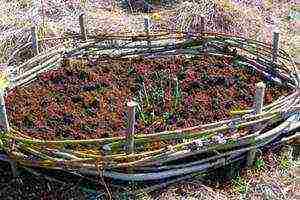 You can decorate even the most unsightly corner of the garden and at the same time add a piece of light romance to it with the help of climbing roses. These extraordinary, beautifully flowering climbing plants please the owners with their flowering almost throughout the season. But for it to be flawless, climbing roses require proper planting and special care. We will tell you about all the intricacies and nuances of growing climbing plants in this article.
You can decorate even the most unsightly corner of the garden and at the same time add a piece of light romance to it with the help of climbing roses. These extraordinary, beautifully flowering climbing plants please the owners with their flowering almost throughout the season. But for it to be flawless, climbing roses require proper planting and special care. We will tell you about all the intricacies and nuances of growing climbing plants in this article.
Curly rose: planting and care, photo
Any plant in the garden or in the summer cottage requires care. Particular attention must be paid to some flowering crops, which include weaving roses.and with long branches... Abundant and long-lasting flowering of this beautiful plant can be achieved only with the exact fulfillment of all the rules for planting, careful care throughout the year, timely pruning and protection from winter frosts and pests.
Choosing a landing site
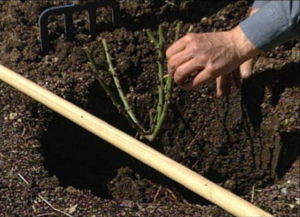 Roses are photophilous, therefore, with a lack of sunlight, fresh stems will develop poorly and will bloom only in the next season. However, the midday sun can burn the plant. The place for planting roses should be such that in the hottest hours the bushes were in partial shade... The best option would be an area that the sun heats up in the morning.In the morning hours, the dew from the leaves will quickly evaporate, and the viral diseases of the roses will not be afraid.
Roses are photophilous, therefore, with a lack of sunlight, fresh stems will develop poorly and will bloom only in the next season. However, the midday sun can burn the plant. The place for planting roses should be such that in the hottest hours the bushes were in partial shade... The best option would be an area that the sun heats up in the morning.In the morning hours, the dew from the leaves will quickly evaporate, and the viral diseases of the roses will not be afraid.
Curly roses are also finicky. They do not tolerate drafts well, and therefore the corners of buildings are not suitable for planting them. Do not plant them in areas where roses have already grown and in wetlands. It is best to choose a bed with a slope so that water does not stagnate in the ground. The roots of the plant reach about two meters in length, so if the moisture of the soil is constantly very high, the flowers are planted on a hill.
Climbing shrubs for decoration can be planted along the walls of the building... So that their roots are not depleted, the distance from the wall should be at least 60 cm. In any case, the planting of climbing roses should take place near some kind of support. These can be fences, nets, pergolas, arches, walls, or specially crafted pillars or cones.
When to plant climbing roses?
In areas with a temperate climate, shrubs are planted in open ground in late September - early October. Within two weeks, they will give the first roots and before the onset of cold weather they will have time to get stronger. In the spring, the root and aerial parts will begin to grow actively, the bush will become lush, gain strength and bloom. However, in the northern regions, climbing roses are best planted in the spring, since the bushes planted in the fall will not have time to adapt, and can freeze out in winter.
Plants, which were planted in spring, are delayed in their development by about half a month and require increased attention. Before planting in the ground, such seedlings are cut into three buds.
Selection and processing of seedlings
Beautiful curly rosals can only be obtained in the presence of healthy seedlings... Their viability and quality are indicated by the appearance of the trunk. It should only be whitish green, not gray or brown. The acquired seedlings in open ground are not planted immediately. They must first be prepared:
-
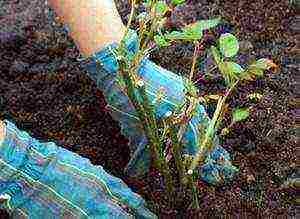 Soak the plant completely in water for a day.
Soak the plant completely in water for a day. - Shorten healthy roots by 15 cm, and cut off the crushed and weakened ones completely. A small bunch should remain.
- Shorten strong branches of roses by 15-20 cm, and remove weak ones completely.
- Sprinkle the cuts with crushed charcoal.
- Treat the roots with Heteroauxin or Kornevin.
Thanks to this preparation for landing the bushes will begin to actively grow, and during the flowering period, many buds are formed on them.
Soil preparation
Climbing roses love fertile, loamy, well-drained soil. Only heavy clay and sand are not suitable for growing them. Therefore, clay areas are diluted with sand, and sandy areas - with clay. More suitable in chemical composition and crumbly soil will become after adding a small amount of lime to it.
When digging, the fertility of the soil can be increased by adding to it:
- phosphate fertilizers;
- humus;
- humus;
- phosphorobacterin (special soil bacteria).
The soil is prepared for planting climbing shrubs in advance. It is necessary to dig it up several times at the end of summer, and then loosen it also in the spring.
Landing features
The roots of a young plant should not experience a lack of space, so the holes for them should be free enough. The optimal depth is considered to be 60-65 cm. In order for the root system to develop freely, the distance between plants must be at least one meter.
When planting roses in the hole, it is necessary observe the following recommendations:
-
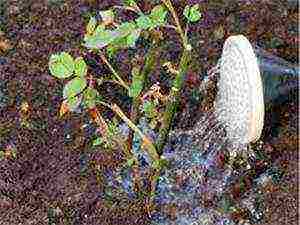 About five kilograms of the nutrient mixture is preliminarily introduced into each hole. You can use peat compost.
About five kilograms of the nutrient mixture is preliminarily introduced into each hole. You can use peat compost. - The roots of the roses should be free in the hole. The voids between them are necessarily filled up.
- The root collar of the plant is covered with soil by about 10-12 cm. This will help to protect it from frost in addition to insulation.
- The planted rose is watered with a bucket of warm water.
- The remaining space is filled with a mixture and lightly compacted.
The support to which the rose will be attached in the future should not interfere with the development of the root system. If the support is portable, then you can use special tripods, trellises or trellises. The pole and tripods can be made by yourself by knocking down for this wooden beams from 2.5-3 meters high... They will look gorgeous as arch supports, on both sides of which two bushes are planted. By the end of the second year, they will be completely entwined with curly roses with delicate flowers (pictured).
Caring for planted bushes
The main rules for caring for climbing roses include regular watering, timely feeding of plants, garter and pruning of shoots, sheltering bushes for the winter and protecting them from pests and diseases. Let's consider each point in more detail.
Watering and feeding
Climbing shrubs do not like excess moisture and tolerate drought without problems. It is recommended to water them once a week with a small amount of water, which should not be cold. Overmoistening plants can lead to viral diseases and poor appearance of the bushes.
Fertilizing roses is best manure or other organic fertilizers, alternating them with mineral dressings. It should be borne in mind that young plants at first will be sufficiently fertilized when planting soil. Therefore, it is not necessary to feed them too often. The next year after planting, caring for climbing roses will consist of fertilizing with fertilizers of the following composition:
- fresh black soil;
- humus;
- phosphorus complementary foods;
- humus.
With such a mixture, the soil in which the roses grow "revives" in spring and autumn. If it is not possible to prepare the composition yourself, then you can buy ready-made fertilizer for roses.
Pruning shoots
All climbing roses are divided into two types, each of which requires a certain pruning:
- In shrubs flowering from June to July, after planting, all shoots are shortened. There should be shoots 30 cm long. New stems that appear during active growth are cut off as needed to form a beautiful bush.
- Roses with a small number of basal shoots, which appear only on old branches, are shortened to 30 cm in the first year. The next year after planting, all old shoots are cut out completely.
Garter of climbing roses
After pruning, new branches will begin to grow, which need to be guided, giving the bush the intended shape. To form more buds, individual lashes are tied. At the same time, it is undesirable that they are directed only upward, since with this arrangement, the buds are formed only at the tops.
For lush flowering bushes there are several ways to tie:
- Shoots can be fanned out, leaving the side branches not tied up. They will not interfere with each other, freely extending to the sides and up.
- The main shoots are located horizontally, tied to the support. After a while, they will give new side branches, which will grow upward, forming a cloud of beautiful flowers.
- In order for the curly branches to braid an arch or a pillar, they are tied up in a spiral, twisting around the support.
Whichever way the bush is formed, one should not neglect the care of climbing roses and preparing them for winter.
Protecting roses from frost
 Before proceeding with the shelter, the bushes must be prepared. To do this, remove the leaves from them, cut out old loops and weak shoots. As a result there should be 11-12 healthy and strong shoots... All work is carried out in dry weather.
Before proceeding with the shelter, the bushes must be prepared. To do this, remove the leaves from them, cut out old loops and weak shoots. As a result there should be 11-12 healthy and strong shoots... All work is carried out in dry weather.
The way a climbing plant hides depends on the region in which it grows. In regions with a mild climate, the branches can not be removed from the support, covering them first with spruce branches, and then wrapping them in film.
In areas with severe winters, the plants are completely removed from the support. First, they are collected in a large bundle and tied.After the air temperature drops to -5C, they gently tilt to the ground, where they are fixed with wire or pegs. The base of the bush is sprinkled with a mixture of peat and soil, and the shoots are covered with spruce branches. From above everything takes cover thick film or agrofiber.
It is very important to remove the shelter on time in the spring. Otherwise, in a humid environment and without fresh air, the roses may suffocate and start to hurt. On open bushes, shoots are refreshed and tied to supports. The first feeding is recommended only after the appearance of young leaves.
Diseases of climbing roses
In case of errors in the care and incorrect arrangement of the bushes on the site, they may be affected by the following diseases:
-
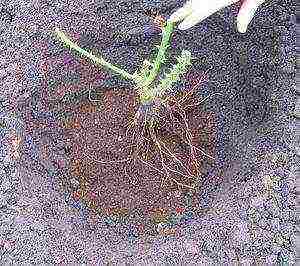 Black spot occurs on young shoots in warm weather and heavy rains. You can recognize it by the black and brown spots on the leaves, which have a yellow halo. All affected leaves are removed from the plant and burned. Feeding is done with phosphate and potassium.
Black spot occurs on young shoots in warm weather and heavy rains. You can recognize it by the black and brown spots on the leaves, which have a yellow halo. All affected leaves are removed from the plant and burned. Feeding is done with phosphate and potassium. - Powdery mildew progresses with increased humidity. If a white bloom appears on the leaves and stems, and the flowers do not bloom, then this indicates that the plant is sick. The bushes are treated with iron and copper sulfate, all the affected areas are cut out, the soil is dug up.
- Bacterial cancer can be recognized by the growths and bumps on the roots. They are soft at first, but darken over time. The plant begins to dry out and dies. The affected roots are cut out, and the remaining ones are treated with copper sulfate.
When treating climbing roses, it must be remembered that all cut off affected areas must be burned... Otherwise, they can infect other plants.
Proper planting and care is the key to the abundant and long-lasting flowering of these royal flowers. Those who decide to grow climbing roses on their site will never regret it.
Planting and caring for climbing roses
 The rose is often called the queen of flowers. This flower has been known for a long time: it was mentioned in the legends of the ancient Hindus. According to the legends of other peoples, the rose was created by Allah himself, so that she would become the mistress of flowers instead of a beautiful, but too lazy lotus. The rose is found in almost every garden, because planting and caring for it in the open field, as well as reproduction, is within the power of every hardworking gardener.
The rose is often called the queen of flowers. This flower has been known for a long time: it was mentioned in the legends of the ancient Hindus. According to the legends of other peoples, the rose was created by Allah himself, so that she would become the mistress of flowers instead of a beautiful, but too lazy lotus. The rose is found in almost every garden, because planting and caring for it in the open field, as well as reproduction, is within the power of every hardworking gardener.
Description, varieties and varieties
Among the representatives of garden flowers, the rose has few equal in terms of cost-benefit ratio and beauty. The variety of species and varieties baffles any novice gardener. Reviewing many photos, he has to opt for only a few varieties, because it is impossible even physically to plant all types of roses in his flower garden. When choosing your rose variety, do not forget that many of them are thermophilic and are not able to winter outdoors in temperate climates. Roses are park, climbing, hybrid tea, miniature, ground-blooded.

Park roses
Park roses... The most decorative of all. They are distinguished by good winter hardiness, they feel great in temperate climates, even without shelter for the winter. They are among the first to bloom in late May or early June and bloom from two weeks to one and a half months, but, unfortunately, only once. Park rose bushes are usually from 1 m to 3 m in height, unpretentious and undemanding to care for. In addition, there is no need to trim them annually.
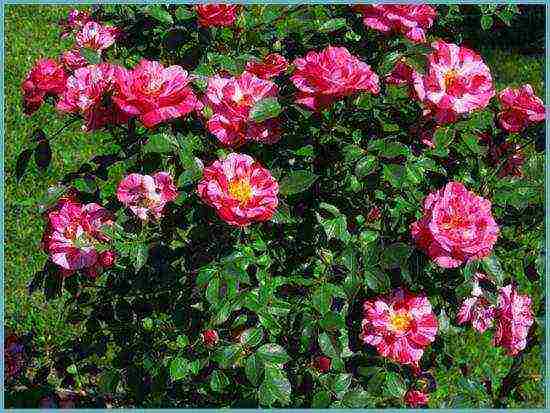
Hybrid tea roses
Hybrid tea roses. The most planted group of roses at the moment. They are not frost resistant. Absolutely all species of this group must be covered for the winter. They have rather small bushes, therefore, to achieve a decorative effect, it is necessary from 5 to 10 bushes per 1 sq. m.

Floribunda roses
Floribunda roses. These roses are gaining in popularity.They are not too inferior to hybrid tea roses in size and smell, but they are significantly ahead of them in frost resistance and flowering continuity. In large flower arrays, they occupy the main place.

Miniature roses
Miniature roses. A group of tiny and harmonious colors. It is unusually easy to adapt to any environment, bloom thickly, brightly and for a long time, until the deepest autumn. For the winter, they are content with light shelter.
Climbing roses. They can be conditionally divided into two subgroups: large-flowered and small-flowered.
Climbing roses are referred to small-flowered roses. Their characteristic feature is long flexible lashes that spread or rise. Such roses need support for growth and a little shelter for the winter. It is not recommended to prune these roses in the fall, because they bloom along the entire length of those shoots that have already wintered.

Climbing rose
Large-flowered climbing buds larger than 4 cm are collected in inflorescences. Some varieties are similar to hybrid tea. Most of them bloom twice a season. These roses can bloom on young shoots released only this year, which means that if your rose is frozen in winter, then in summer it will certainly bloom anyway. This subgroup is highly disease resistant. Large bushes reach 2 m and do not require support, with the exception of some spreading varieties.
Ground cover scrubs. These varieties are created in order to create carpets of roses that will bloom continuously and densely. They are distinguished by their amazing unpretentiousness, winter hardiness, immunity to diseases. But before choosing these roses, be sure to check to what size they can grow.
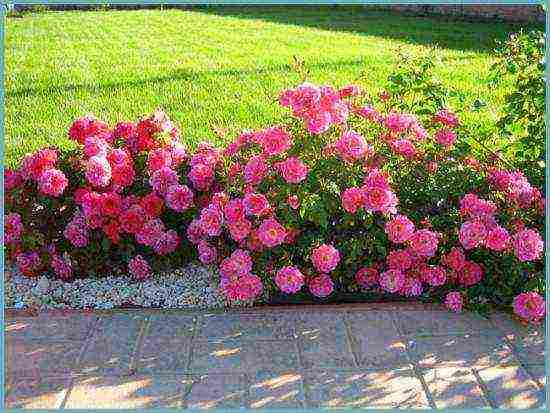
Ground cover rose
Ground cover roses can be divided into 4 subgroups:
- low creeping - reach 30–45 cm in height and 150 cm in width;
- creeping high - reach 45 cm in height and more than 150 cm in width;
- drooping small - reach 90 cm in height and up to 150 cm in width;
- drooping large - reach 100 cm in height and 150 cm in width.
Modern parks. This group of roses includes hybrids of Cordes, musk, rugosa, moesi and shraba roses. The group itself was defined not so long ago and is called shrabs for short. This includes all species that do not fall into other groups and have certain traits:

One of the varieties of the modern park rose
- The inflorescences and buds of this group of roses often have an atypical shape of different shades.
- Repetitive flowering is a characteristic feature. Shrabs bloom for a long time and actively.
- Roses with a unique aroma in this group are found more often than among the same hybrid tea.
- The prevailing number of scrubs has a powerful bush reaching 2 m, but at the same time they are graceful and voluminous.
- Absolute undemandingness. Absolutely any novice gardener can grow a scrub.
- Good immunity to diseases and excellent frost resistance.
Planting a rose with seeds
Many gardeners claim that it takes a long time for rose seeds to germinate, but you can speed up this process by leaving the seeds in the cold for a long time. Seed planting can be done in three different ways:
- for the winter in open ground;
- in the spring in open ground;
- seedlings in pots for the winter.
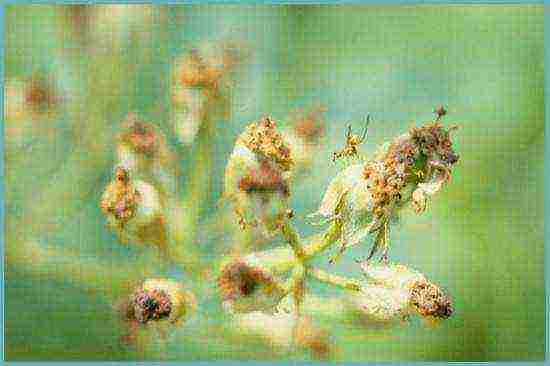
Seed boxes of roses
Sowing seeds for the winter in open ground. With this planting method, you do not need to keep the seeds in the cold, as this will happen anyway. But soaking the seeds for a while in a growth stimulator still does not hurt. Before the onset of frost, a plot of land is dug under a bed of roses, adding humus, compost or peat. In the garden, furrows are made no deeper than 4 cm in which the seeds are planted at a distance of 15 cm from each other. Cover furrows with soil. If the winter is especially frosty or with little snow, it is recommended to cover the garden.
Garden bed for spring sowing it is best to prepare it in the fall, but if there was no such opportunity, then you can do it in the spring when the soil thaws.Planting material must be kept for some time in a growth stimulator. Seeds, as in the case of autumn planting, must be planted in furrows at a distance of 10–20 cm and at a depth of 1 cm to 3 cm.
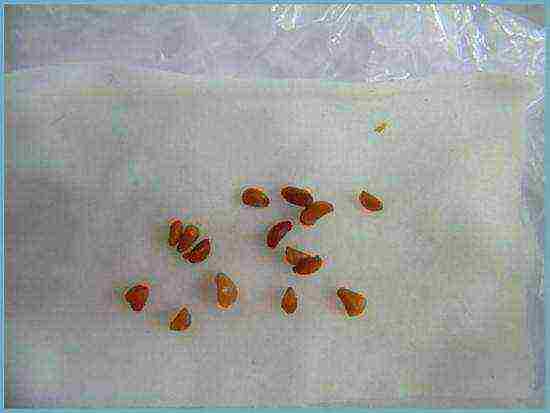
Treatment of rose seeds before planting
Before planting seeds for seedlings, they need to be kept at a low temperature for several months. It is preferable to plant in boxes at the end of February. The pots should be filled with a mixture of earth, sand and peat. Slightly press the seeds soaked in a growth stimulator into the prepared soil and cover with a small layer of fine sand. Spray enough water onto the sand and leave in a cool place.
Advice. When the first sprout appears, move the boxes to a bright, but protected from direct sunlight place. The rest of the seedlings will not be long in coming.
After the seedlings have 2-3 leaves, they need to be planted in separate pots, and at the beginning of May the plants can be transferred to open ground.
Plant care
You need to choose a sunny place for roses. In the shade, they bloom worse and paler, in addition, spots and blind shoots may appear on the leaves. The site should be well ventilated, but at the same time protected from strong cold winds. Roses have no special requirements for the soil; any, except for heavy ones, are suitable for them.
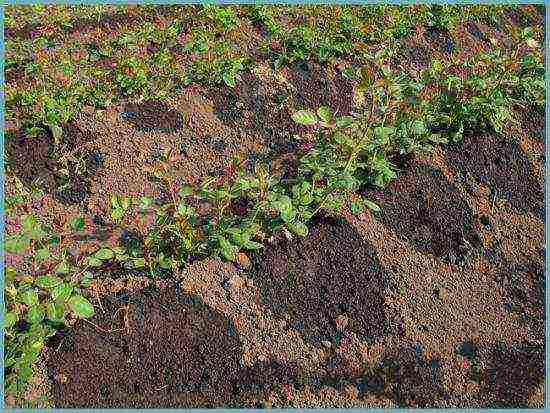
Rose bushes after watering
Roses are watered once a week so that the soil is soaked by 20-25 cm, otherwise the plant will put down superficial roots that can be easily damaged. In hot weather, watering is doubled. If the situation develops in such a way that it will not be possible to water the roses for a long time, it is necessary to lay the bases of the bushes with grass, humus or tree bark. Doing this will help keep water in the roots of the roses and also make it harder for weeds to grow.
In the fall, most varieties are left for wintering in the open field, after wrapping the bush in a tight cotton bag, and sprinkling the roots with earth and sand.
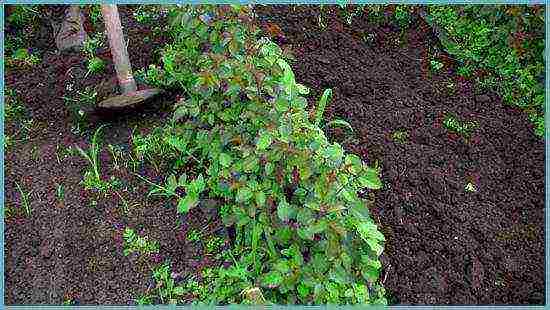
Loosening the soil
Cupping plays a significant role in the health of flowers. If roses are cut off in a timely manner, you can increase the number of leaves and buds. For the winter, new shoots should be cut off if you are not sure that the rose will survive the winter well. New shoots will only take away strength.
Fertilizing and feeding roses
The best fertilizer is, of course, natural fertilizer. Such as dung. Horse manure, which has lain for at least six months, will be an ideal top dressing for roses. But with fresh chicken or pork dung, you should beware. It is too sour for roses and is quite capable of harming young, unstable shoots. And in general, fresh manure does not bring anything good to the soil, because it blocks nitrogen.
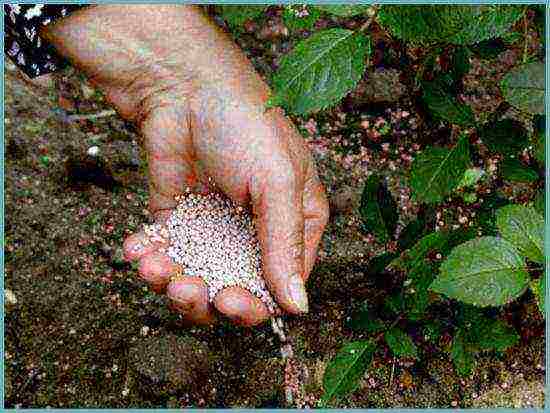
Root dressing of roses
Before flowering, when small buds have already appeared on the bushes, the roses are fed with calcium nitrate (1 tablespoon per 10 liters of water). At a time when the bush is actively growing and developing, it must be fed with infused mullein, mineral fertilizers or herbal tincture. Such dressings are done every two weeks.
Advice. It is best to apply fertilizer in a dissolved form after watering.
In the second half of summer, you should stop feeding and let the plant prepare for winter.
Plant propagation: methods
Summer rooting of cuttings. For cuttings, the stems are not chosen the youngest, but not the old ones either. A sign that the stem is suitable for grafting is the ease with which the thorns break off. The stems are cut early in the morning and cut with a treated sterile knife into 12–15 cm cuttings. Each piece should contain two or three leaves and the same number of buds, but there should be no flowers on it. Leaves must be removed or cut by a third. This will prevent excessive moisture evaporation.
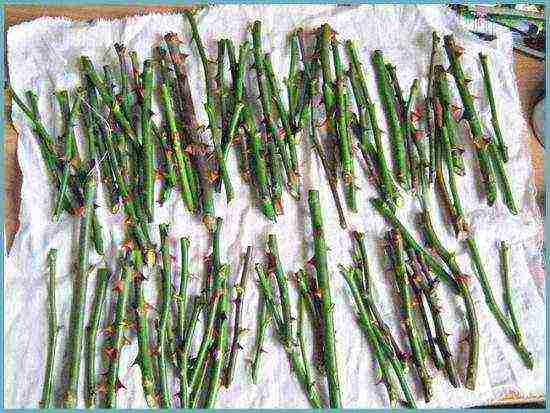
Rose cuttings
The wells must be pre-treated with a solution of potassium permanganate, and the future sprouts must be soaked in a honey solution (0.5 teaspoon honey in a glass of water), into which you can add crushed rose leaves.Cuttings are tilted into the holes at an angle and mini-greenhouses are made using glass jars. After a couple of weeks, you need to remove the cans for a short time to harden the processes. And after a week from the beginning of hardening, the cans can be completely removed. By autumn, when the shoots reach 30 cm, buds may appear on them, they are pinched so that the rose spends all its energy on the formation of the root system, and not on flowers.
Planting cuttings in the fall. It happens that you got a unique rose in the fall, and it will not be possible to force it to take root by winter, and it is not always convenient to store cuttings in the house in winter. In such cases, divide the stem into cuttings and dig them into the garden. Cover the top with a dry layer of leaves or covering material so that the plant does not freeze in winter, and in the spring, transfer it to a permanent place in the usual way.
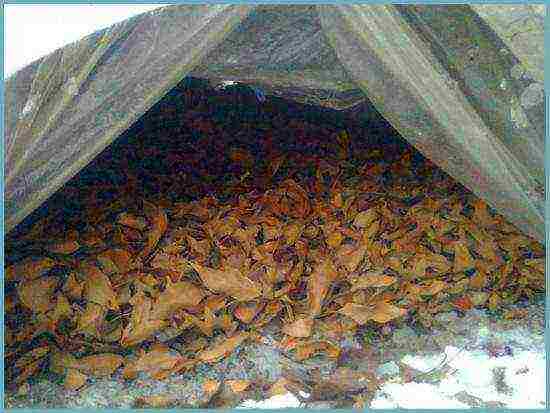
Winter shelter for rose bushes
Rooting in potatoes - This is the most common method of breeding roses, because roses are fed from potatoes in addition to carbohydrates and starch. In a lighted place, it is necessary to dig a groove up to 15 cm deep and fill it with sand by about a third. We stick the cuttings up to 20 cm long into the potato and deepen it by 10 cm. Then everything is done as in the usual way: cover with jars and after a while harden the plants. Every five days, you can pour a sugar solution (2 teaspoons of sugar in a glass of water).
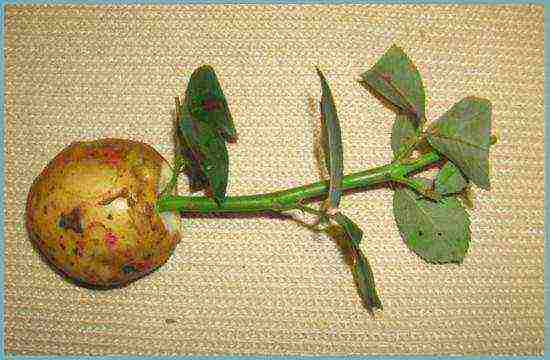
Rooting a rose in a potato
Reproduction in a package. The lower part of the cuttings is moistened with aloe juice in a 1: 9 ratio of aloe juice to water and stuck into sterile soil, packed in a bag. I fill the bag with air, tie it securely so that the air does not come out and hang it on the window. A month later, when the roots appear on the cuttings, they are planted in the above way.
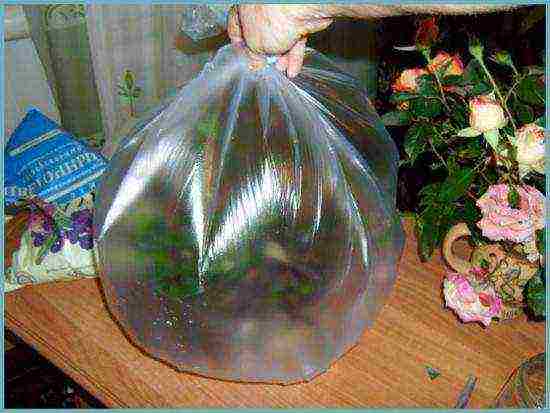
Reproduction of a rose in a package
Rooting in water. Freshly cut roses are rooted in this way. Plant stems cut into cuttings must be placed in distilled water. Remember to remove all thorns and flowers. Leaves can also be trimmed or shortened. Change the water periodically until the stems take root.
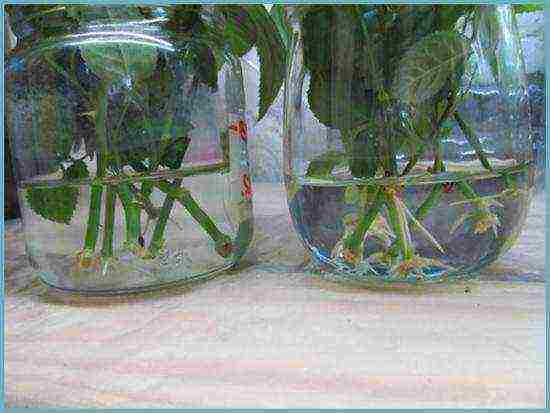
Rooting rose cuttings in water
Advice. With any rooting method, always remove the thorns and inflorescences from the stem, and shorten the leaves by a third.
Diseases and pests
Many varieties of roses have a fairly strong immunity to various kinds of diseases, but this does not mean that roses do not get sick at all. Most often, roses are observed with diseases caused by various fungi.
- Rust appears in spring. It is characterized by spots on the upper part of the leaves and bright orange clusters of spores on the inside of the leaf, which begin to turn black by the second half of summer. The rose begins to lose its leaves, and the stems acquire a reddish tint. For treatment, decoctions of field ivy are used, damaged parts are immediately removed if found.
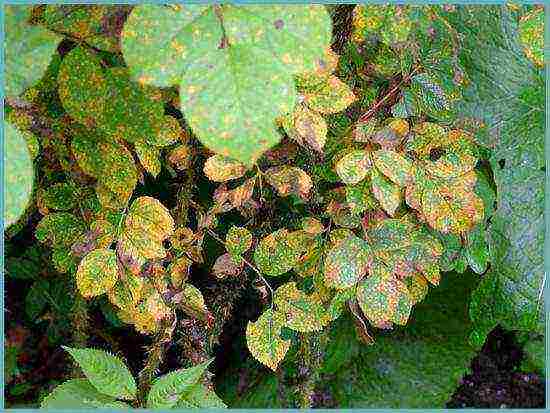
Rust on rose leaves
- Black spot appears in late summer with excess water or lack of nutrition. The leaves of roses quickly become covered with dark spots with yellow edging, then the spots pass to the stems of the plant, the flower loses its leaves and dies after a while. The treatment for this disease is the same as for rust.
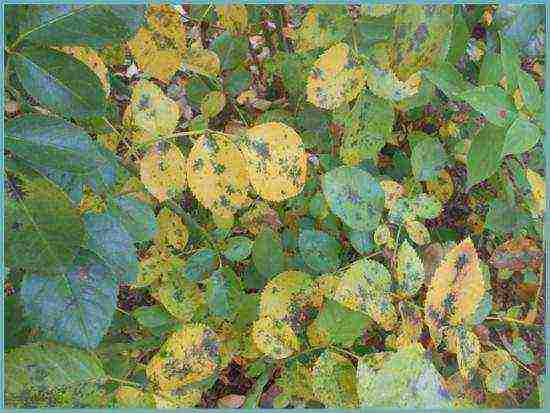
Black spot on rose leaves
- Powdery mildew is another common disease. It got its name because of the peculiarity of forming a flour coating on the leaves and stems of the plant, on which drops later appear. This disease mainly affects varieties grown in greenhouses and indoor plants. The disease spreads very quickly and infects neighboring bushes, therefore, at the slightest suspicion, immediate action is required. Damaged plants are cut and burned, and ash must be added to the ground under the bushes and dug up.

Powdery mildew on the stems and leaves of a rose
Rose: combination with other plants
As neighbors for roses, you can select plants that will not only look good next to you, but will also bring a lot of benefits. For example, they will protect the rose from harmful insects.
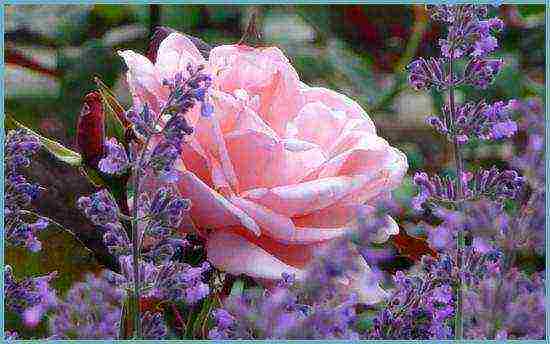
Rose combined with lavender
If you plant nasturtium or lavender together with roses, then this is guaranteed to protect the roses from the appearance of aphids. But marigolds and calendula will get rid of beetles. Onions and garlic have a beneficial effect on the health of roses and even add aroma to them.
Rose in landscape design
Most gardeners prefer to plant roses in separate flower beds, but recently this approach to using roses in landscaping has become less popular. Indeed, many roses are in perfect harmony with perennials that decorate the borders, or with low groups of shrubs. When choosing color combinations, it is important to take into account the shades and shapes of the inflorescences.
For mixborders, it is better to choose musk rose hybrids, since they are the owners of regular-shaped bushes and are covered with bouquets of bright flowers. Some varieties of floribunda roses and not too tall shrubs are preferably planted in a flower bed with perennials. Choose varieties with medium-sized flowers for such a bed so that they are in harmony with perennials, and not compete.

Rose in landscape design
Rose varieties, which are among the most unpretentious to care for, can be placed in problem areas of the garden. Climbing types of roses will help to disguise buildings and unsympathetic structures. Ground scrubs will look perfect on slopes and slides. A huge variety of varieties and types of roses will allow you to create your own unique and unique landscape design.
Many novice gardeners, considering the rose the queen of flowers by right, are afraid to start growing it on their site, believing that she needs royal care. However, this is not at all the case. Following simple rules and tips, growing a rose will be a pleasure for you, and your rose garden will be a source of pride.
Growing roses from seeds: video
Rose varieties: photo




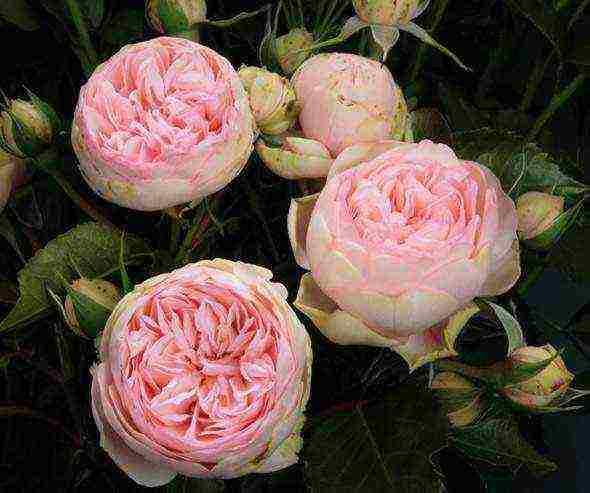


Climbing roses include types of rose hips, as well as several varieties of garden roses, branching with rather long stems. They are directly related to the genus Rosehip. And these plants are very popular in vertical gardening of various structures, buildings and walls, and arbors. Such flowers can decorate both a large structure and a very small one. These plants are widely used to create various structures in the garden, namely, columns, gazebos, pyramids, garlands, as well as arches. And they are also remarkably combined with other plants, in this regard, their popularity is no less than that of a room or bush rose.
Features of climbing roses
There is no general description for this type of plant, because they have many different forms and varieties. However, there is a classification of climbing roses, which has been accepted in international floriculture practice.
First group
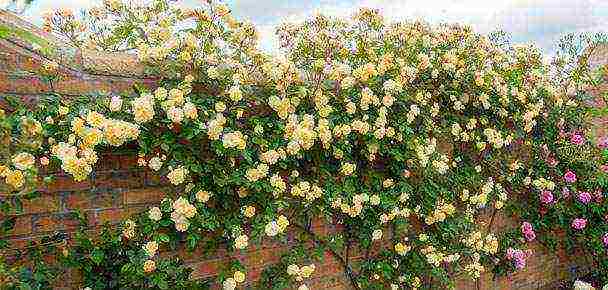
Such plants are called climbing roses or rambler roses (Rambler). These flowers have long, flexible shoots that are arched or creeping. They are painted in a deep green color, and spikes are located on their surface. In length, they can reach more than 500 centimeters. Glossy leathery leaves are small. Flowers can be double, semi-double and simple, their diameter, as a rule, does not exceed 25 millimeters. They have a rather weak aroma. The flowers are part of the inflorescences, which are located along the entire length of the stems. Flowering in such plants is quite abundant, and it lasts a little longer than 4 weeks. Flowering is observed in the first half of the summer period. A very large number of varieties have frost resistance, and such plants are able to overwinter normally even under a relatively light shelter. This plant was born thanks to such species as: multi-flowered rose (multiflora) and Vihura rose.
Second group

Climbing (Climber) or large-flowered climbing roses (clammers) were bred by breeders when crossing groups of rambler roses with hybrid tea, tea, remontant roses, as well as floribunda roses. The length of the stems of such climbing roses can reach 400 cm. The flowers are quite large (diameter is more than 4 centimeters), and they are part of small loose inflorescences. Abundant flowering. A large number of varieties bloom 2 times during the season. The flowers have a shape similar to hybrid tea roses. These flowers are relatively frost-resistant and resistant to powdery mildew.
Third group
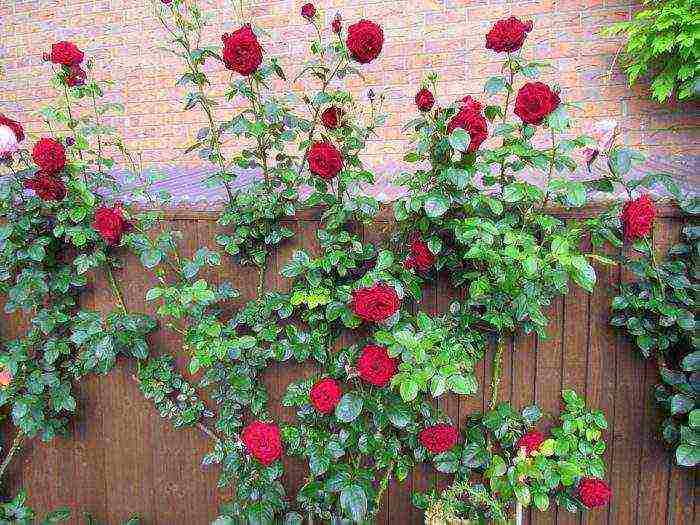
Climbing was formed by large-flowered mutating shrub roses, namely: grandiflora, hybrid tea, and floribunda. The difference between such plants and producing species is that they have even more vigorous growth and very large flowers (diameter from 4 to 11 centimeters), while they can be either single or part of not very large inflorescences. They also differ in fruiting, which occurs at a later date. Most of the varieties are distinguished by repeated flowering. These plants are cultivated only in the southern regions of the temperate zone, where the winter period is relatively warm and mild.
Planting climbing roses in open ground
Optimal time and place for landing
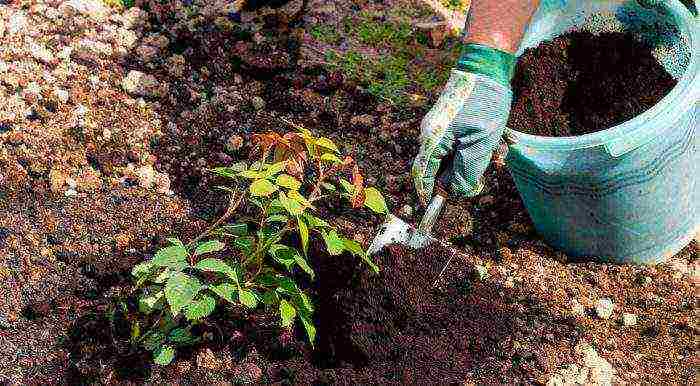
Absolutely all types of such plants are very capricious in nature. The same applies to climbing roses. To plant and care for such a plant, you need to adhere to certain rules. And you should also take into account the advice of experienced florists on the cultivation of a climbing rose. The choice of a site for planting must be approached with all responsibility. Such plants simply need a plot that will be illuminated by the sun from morning until lunchtime. In this case, the dew on the plant can dry out, which will help to avoid the appearance of fungal diseases. At lunchtime, when the sun's rays are most scorching, this area should be shaded, otherwise burns may appear on the surface of the foliage and petals. Also, a suitable site should be protected from northeasterly and northerly winds because it is quite cold. It is not recommended to decorate the corner of buildings with climbing roses. The fact is that the draft present there can destroy the delicate plant. For planting such flowers, experts advise choosing a site on the south side of the building. In order to plant climbing roses, you need a strip of soil only half a meter wide, but you should take into account that any structure, building or plant should be located at a distance of about 50-100 centimeters from such a flower.
Suitable soil must be water-permeable. If, at the site chosen for planting, the groundwater is located very close to the surface, these plants are planted on a special previously prepared elevation. The roots of this type of roses in some cases can be buried in the ground up to 200 centimeters. In order to prevent stagnation of liquid in the root system, the selected area should be located at least at a not very large slope. Loam is considered ideal for planting a climbing rose. If the soil is sandy, then it must be corrected before planting by adding clay when digging, and sand must be added to the clay soil. Such plants need soil saturated with nutrients, so the introduction of humus or humus is mandatory. You should also add bone meal to the soil, which is considered an excellent source of phosphorus. Prepare the soil well in advance. Ideally, this should be done 6 months before planting, but preparation can also be done 4 weeks before planting the rose.
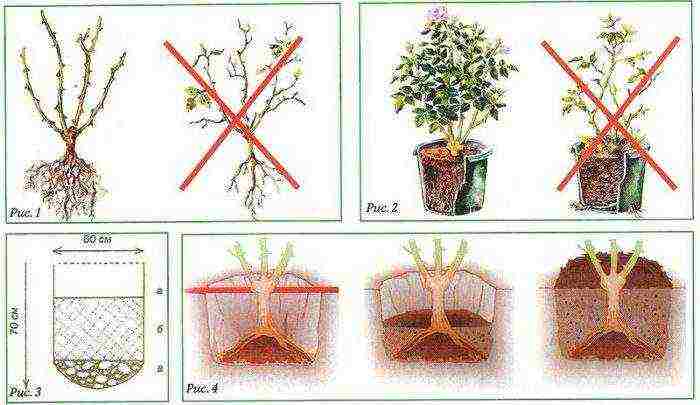
In temperate climates, climbing roses are recommended to be planted in late September to mid-October.Planting can also be carried out in the spring. It can be held from the second half of April to the last days of May.
Autumn planting
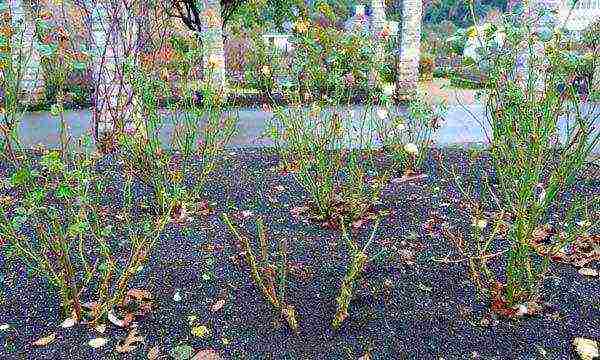
If you are going to plant a climbing rose, you must first learn how to choose the highest quality planting material. Nowadays, you can buy seedlings of roses that are self-rooted, as well as those that are grafted onto rose hips. But how are they different? Grafted seedlings have one important difference from self-rooted ones. The fact is that the root system of such a seedling belongs to the wild rose, and on it there is a scion belonging to a varietal climbing rose. In this regard, planting and caring for a self-rooted rose should be somewhat different than for a grafted one. So, for example, a grafted seedling must be buried in the soil during planting in such a way that the place where the graft is located is underground at a depth of 10 centimeters. With this method of planting, the part of the plant that was grafted begins to form its own root system, while the roots of the rosehip become unnecessary over time and die off. In the case when, during planting, the scion was not buried in the ground, but remained above its surface, it can lead to the death of the plant. The fact is that the dog rose is a deciduous plant, and the grafted rose is an evergreen. If the planting was carried out in violation of the rules, then such a discrepancy between the rootstock and the scion can lead to the death of the cultivated part of the plant.
Seedlings with an open root system must be immersed in a container of water for 1 day, and this should be done immediately before planting in open ground. After that, you should break off all the leaves and cut off, using a pruner, those stems that are unripe or have been damaged. You should also trim the root system and the aerial part, leaving 30 centimeters each. Places of cuts should be treated with crushed charcoal. If you use grafted seedlings for planting, then they must carefully remove all the buds that are located below the scion. The fact is that rosehip shoots will begin to grow from them. Next, the planting material should be disinfected. To do this, it must be dipped in a solution of copper sulfate (3%).
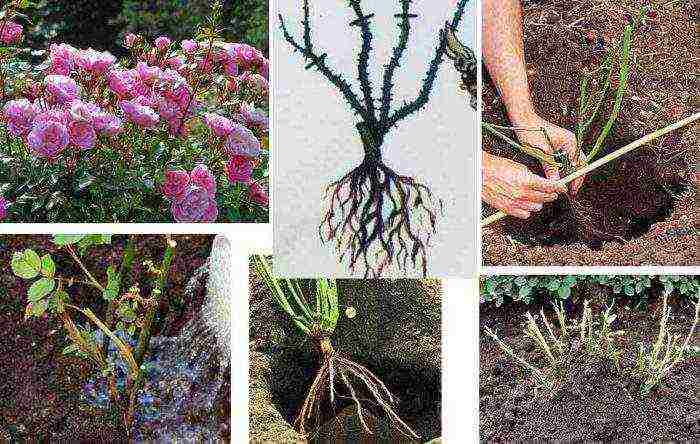
The hole for planting a rose should be 50x50 in size. At the same time, a distance of at least 100 centimeters must be maintained between the planting pits. The top layer of soil most saturated with nutrients must be removed from the dug hole and combined with ½ part of the manure bucket. Part of the resulting soil mixture must be poured into the hole, and then a relatively large amount of water must be poured into it. This procedure must be carried out a day or two before the expected planting of the plant. On the day when you are going to plant a seedling, you need to prepare a special solution in order to process the root system before planting. To prepare the solution, dissolve 1 tablet of heteroauxin, 3 tablets of phosphorobacterin in 500 ml of water. Then pour this liquid into 9.5 liters of clay talker. Before the seedling is lowered into the hole, its roots should be dipped in the prepared mixture. A mixture of soil and manure should be poured into the hole with a mound. Then you need to place a seedling in the hole, while carefully straightening its roots. Fill the hole with the same mixture of soil and manure and compact the surface of the soil well. Do not forget that the place where the graft is located must be buried 10 centimeters into the ground. In this case, for a self-rooted seedling, the root collar must be buried 5 or more centimeters into the ground. The planted plant must be well watered. After the liquid is absorbed into the soil, it will be necessary to add a mixture of soil with manure to the hole. Then the plant spuds to a height of 20 centimeters or more.
Spring planting
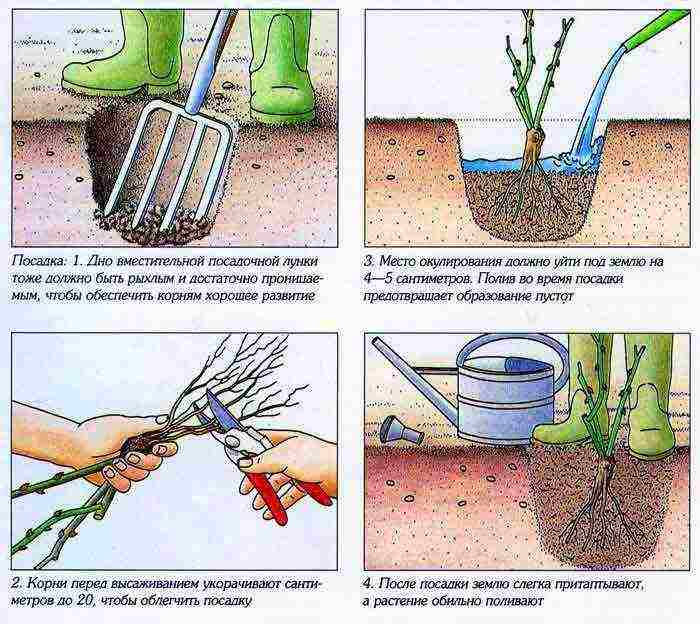
Roses planted in autumn overtake those that were planted in open ground in spring in development.At the same time, the latter need special increased attention to themselves. Before planting seedlings, they should trim the root system to 30 centimeters, and the stems must be shortened to 15–20 centimeters. When the plant is planted, it needs to be well watered and huddled high. Then it should be covered with a transparent film on top, while creating something similar to a mini-greenhouse. In these greenhouse conditions, the rose will take root relatively faster. Do not forget to air the seedling every day, for this you need to raise the shelter for a few minutes. Experts advise airing longer and longer each time, so the rose will also harden. After the threat of night frost is left behind, it will be possible to remove the shelter completely, and pour a layer of mulch on the soil surface in the hole. If the seedling was planted at a time when warm and dry weather was established, then the surface of the holes will need to be sprinkled with a layer of mulch (peat or other).
Outdoor climbing care for climbing roses
How to care for

In order for the climbing rose to grow and develop normally, it is necessary to learn how to properly water, feed, cut the plant. You also need to monitor the health of the rose and destroy pests in time. It is very important to learn how to properly prepare the bushes for wintering. This type of rose needs a reliable support. These plants can easily tolerate drought and therefore should not be watered abundantly. As a rule, they are watered 1 time in 7 days or in a decade, 10–20 liters of water should be poured onto 1 bush. Remember to water more often, but less. To retain water in the hole, it is recommended to build a not very low shaft of soil around it. When 2-3 days have passed from the moment of watering, it will be necessary to loosen the soil surface of the near-trunk circle to a depth of 5 to 6 centimeters. This will help retain moisture in the soil as well as improve air access to the root system. In order to reduce the number of irrigations and practically eliminate the loosening of the soil, you need to cover its surface with a layer of mulch.
Young plants do not need to fertilize the soil until the end of the summer period, since there is a large amount of nutrients in the soil from the moment of planting. At the end of summer, the plant should be fed with a solution of potash fertilizers, this will help the rose to prepare for the winter period. It is recommended to use an infusion prepared on wood ash as a top dressing in this case. In the second year of life, such plants need to be supplemented with mineral and organic fertilizers, while they should be alternated. And roses of the third and subsequent years of life should be fed only with organic fertilizers. So, a solution consisting of 10 liters of water, 1 liter of manure and 1 tbsp is perfect for this. wood ash. If desired, instead of manure, you can take another organic fertilizer. During the period of intensive growth, climbing roses must be fed 5 times, while taking into account that during the flowering period, fertilizers cannot be applied to the soil.
Support for climbing roses
There are a huge variety of supports for this type of rose. So, as a support, you can use an old dried tree, a wooden, metal or polymer arch or lattice, as well as arched rods made of metal. But the best support for such a plant is a building or any structure, but we must remember that plants should be planted at least 50 centimeters, stepping back from the wall. On the surface of the wall, it is necessary to fix the guides to which the shoots of the plant or the lattice will cling. But at the same time, one must not forget that if the stems are located horizontally, then the flowers will grow along their entire length. If they grow vertically, then the flowers will bloom only at the tops of the stems.
In order to fix the stems on the support, it is necessary to use plastic twine. It is forbidden to use wire for these purposes, even if wrapped in a cloth or a sheet of paper. The shoot must be fixed on the support securely, but so that the fastening material does not damage it. Plants should be systematically inspected for the integrity of the fastening materials. The fact is that under the weight of the plant itself or from gusts of wind, the twine can break, and in this case there is a risk of the rose getting significant damage. Step back 30 to 50 centimeters from the bush and then dig the support into the ground.
Transplanting climbing roses
An adult rose may need a transplant only when it has become clear that the place where it grows is completely unsuitable for it. The transplant is carried out in the autumn in September or at the beginning of November, later this should not be done, since the bush will not have time to take root before the beginning of the winter period. In some cases, the plant is transplanted in the spring, but this must be done before the buds awaken. The plants must be removed from the support structure. In ramblers, young shoots are not removed, but their tops are pinched in the last days of August, which will help them become lignified as soon as possible. Stems older than 2 years are pruned. All long stems should be shortened by ½ part for climbers and climbers. After that, the bushes must be carefully dug in a circle, while from its center it is necessary to retreat a distance that is equal to 2 bayonet shovels. It must be remembered that the roots go deep into the soil, and you need to try to dig them out completely, while causing them as little damage as possible. Shake off the soil from the roots, and then inspect them. With the help of a pruner, you need to cut off shaggy, as well as damaged ends of the roots. Dip the plant into the prepared hole and be sure to straighten the roots. Then cover the hole with soil and compact the surface well. Water the plant well. A few days after transplanting, you need to add the required amount of soil in order to level the surface of the trunk circle. At the same time, it is necessary to carry out the hilling of the rose.
Diseases and pests

Aphids and spider mites can settle on a climbing rose. In the event that aphids on the plant are not very much recommended, try to get rid of it using folk remedies. So, you can manually remove insects from a plant. To do this, you need to pinch the part of the plant on which the aphid is located with your fingers and remove it. Remember to wear gloves. But this method can be used only at the very beginning of infection. If there are a lot of insects, then manually removing them will be ineffective. In this case, it is recommended to make a soapy solution. The soap should be crushed with a grater, poured into a container, where water should also be poured. Let the solution stand as the soap takes time to dissolve. Strain it and spray the plant with a sprayer. If after the treatment the insects still remain, then you need to buy an insecticidal agent in a special store, on which there should be a mark "for grapes and roses". For processing in this case, you must choose a calm sunny day. Spider mites can settle on a rose only during a dry hot period, and only when the plant is very rarely watered. Such insects live on the seamy side of the leaves. They feed on plant sap and entangle the leaves with a thin cobweb. In an infected rose, the leaves turn green-silver. Very often, an infusion prepared in wormwood, makhorka, yarrow or tobacco is used to kill such mites. After 3 days after treatment with this infusion, from 80 to 100 percent of the pests should die. To prepare an infusion of wormwood, pour 500 g of freshly plucked wormwood into a container made of wood. You also need to pour a bucket of cold water there.When the mixture is infused for half a month, it is filtered and diluted with water in a ratio of 1:10. It is necessary to process both the plant itself and the surface of the soil around it. If you want to get rid of insects in the near future, then you will need to purchase Fitoverm. You can repeat the treatment a couple of weeks after the first. Before proceeding with the treatment with this tool, it is necessary to study the instructions attached to it, which indicate the features, as well as the required dosage.
Also climbing rose can harm: cicadas, thrips, rose sawflies, leaf rollers. However, if you take care of the flower, observing all the rules, then they will not settle on it. As a preventive measure, plant marigolds in the immediate vicinity of the rose, they will be able to protect this plant from most pests. Also, in the fall and spring, preventive measures should be taken. To do this, the bushes must be treated with a bordeaux liquid sprayer.
For roses, diseases such as bacterial cancer, gray rot, coniotirium, powdery mildew, and black spot are very dangerous.
Bacterial cancer
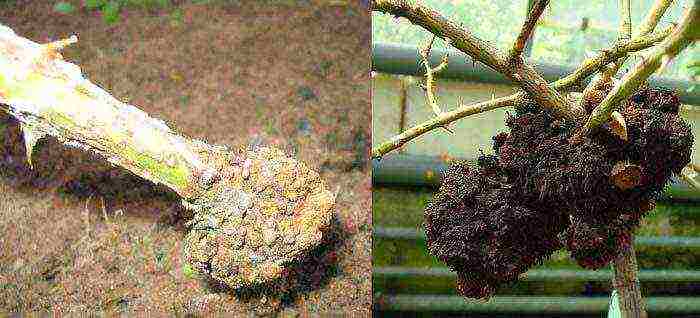
On the surface of the plant, growths of different sizes appear, very soft and lumpy. Over time, they become harder and darker. This leads to drying and death of the plant. Such a disease cannot be cured. During the acquisition of seedlings, you need to thoroughly examine them, and before planting them, you need to disinfect the root system by immersing it for 2-3 minutes. in a solution of copper sulfate (3%). If there are signs of disease on an adult plant, the affected parts must be cut off immediately, while the sections must be treated with the same 3% solution.
Coniotirium
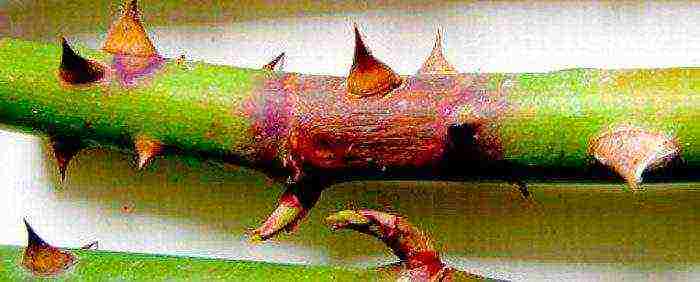
This disease is fungal, which is considered a bark burn or cancer. You can see that the plant is sick in the spring, after the shelter has been removed. On the surface of the bark, you can see specks of brownish-red color, which will eventually turn black and turn into rings around the stem. These stems should be cut off immediately, while capturing part of the unaffected tissue, and destroyed to prevent the spread of the disease. For preventive purposes, in the autumn, nitrogen fertilizer must be changed to potash, which will make the tissues of the roses stronger. And even during thaws, it is imperative to ventilate the plants, raising the shelter.
Powdery mildew
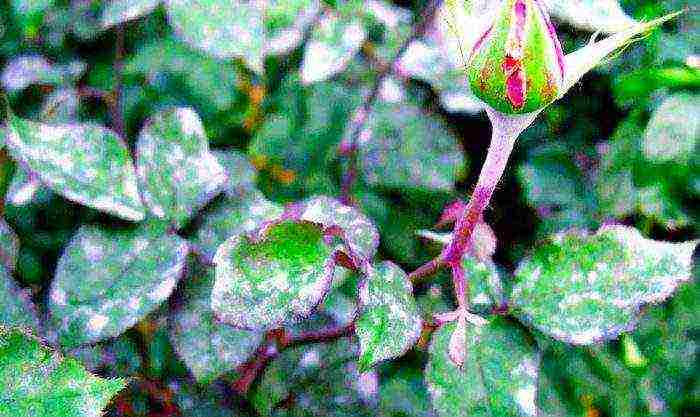
A whitish bloom appears on parts of the roses, which gradually turns brown. The appearance of such a disease can be provoked by high air humidity, a sharp change in temperature, an excessive amount of nitrogen in the soil and violations of irrigation rules. The parts of the rose that are affected by the disease must be cut and destroyed. Next, the plant should be processed using a solution of copper sulfate (2%) or iron sulfate (3%).
Black spot
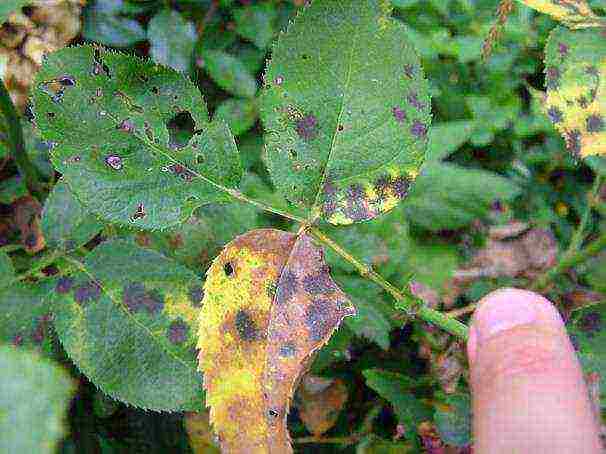
Dark brownish-red spots appear on the surface of the leaves, which are bordered by a yellow rim. Over time, they merge with each other and cause the death of the leaf plate. For preventive purposes, it is necessary to apply phosphorus-potassium fertilizer under the root in the fall. And you will also need a three-stage treatment of the plant itself and the soil near it with a solution of Bordeaux mixture (3%) or ferrous sulfate (3%). The breaks between treatments are 7 days.
Gray rot
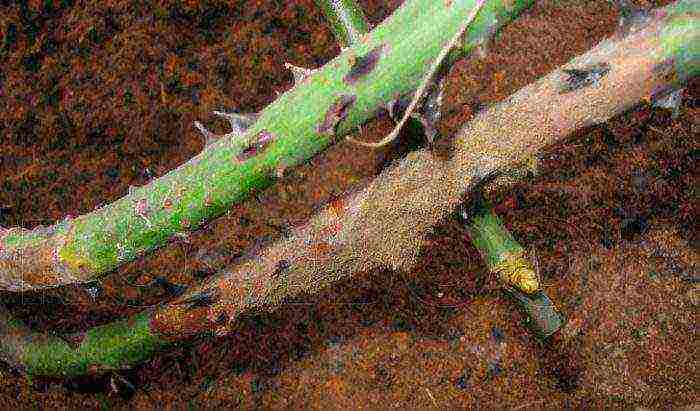
It is capable of destroying almost all parts of the plant (buds, leaves, shoots). Such a rose loses its beauty, and also its flowering becomes relatively scarce. In case of a very frolicking disease, the rose should be dug up and burned. If the disease has just appeared, then it is recommended to treat the bush with a solution prepared from 5 liters of water and 50 g of Bordeaux liquid. In order to cure the plant completely, as a rule, 4 treatments may be needed, the interval between which should be 7 days.
It happens that a seemingly healthy and well-developed climbing rose does not bloom. The point here may not be at all in the disease, but in the fact that a seedling of poor quality (low-flowering) was purchased, and besides, an unsuitable place was chosen for it, and the soil, too, most likely this plant is not quite suitable. And it also happens that last year's stems are damaged during wintering.
Pruning climbing roses
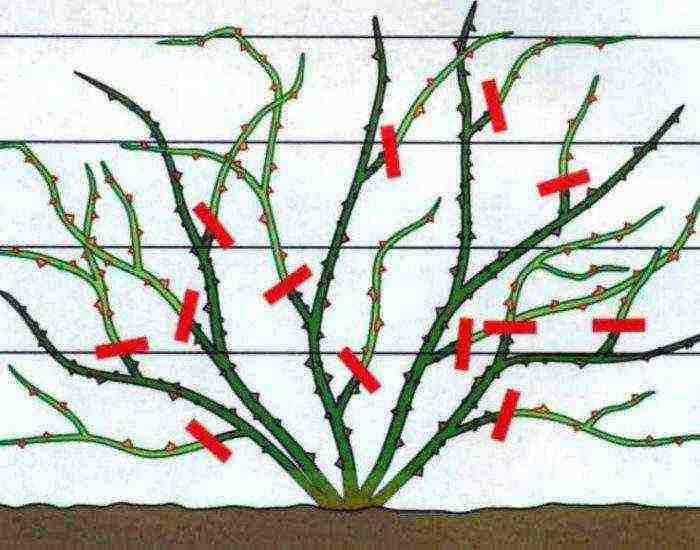
When to prune climbing roses
These plants need pruning, since it is she who allows you to form a beautiful crown, make flowering more abundant, and along the entire height of the bush, improve its decorative qualities. If you cut the plant correctly, then it will delight with its flowering throughout the entire period of intensive growth. Vegetative stems deserve special attention, since most of the flowers are formed on last year's stems. The rose should be pruned in spring or autumn. At the very beginning of the period of intensive growth, absolutely all climbing roses need to remove dead stems, as well as areas that have been frostbitten. And also the ends of the stems should be cut off to the strongest outer bud. The following pruning procedures will be directly related to how many times a particular rose blooms, one or more.
How is pruning done correctly?

Those plants in which flowering occurs 1 time per season, flowers grow on last year's stems. Basal (faded) stems replace regeneration shoots, which can grow up to 10 pieces. Flowers will grow on them only next year. In this regard, faded shoots will need to be removed by cutting them out at the root, while this procedure is recommended to be carried out in the autumn during preparation for wintering. Those climbing roses that bloom several times a season, flowering branches of different orders grow on the main stems for 3 years - from 2 to 5. In the fifth year of life of these stems, their flowering becomes more scarce. In this regard, at the beginning of the spring period, the main shoots must be removed, cut out to the base, and this should be done in the fourth year of their life. The re-flowering bushes should have 3 annual regeneration stems and 3-7 flowering stems, which are the main ones. But at the same time it must be remembered that in most of these roses, flowers are formed on overwintered stems, therefore, in spring, only the upper part with buds, which are underdeveloped, should be cut off from them.
Young roses that have been grafted and planted last or this year need special attention. Until the rose has developed its own root system, you will have to systematically remove the rose hips. After 1-2 years (after the death of the rosehip root system), rose growth will begin to appear.
Reproduction of climbing roses
Can be propagated by seeds, cuttings, layering and grafting. It is easier to do this by layering and cuttings. The seeds must be purchased from a specialized store. If you want to sow the seeds that were collected from roses by you, then you must understand that such plants do not retain the varietal characteristics of the mother plant, and therefore anything can grow in you.
Seed propagation
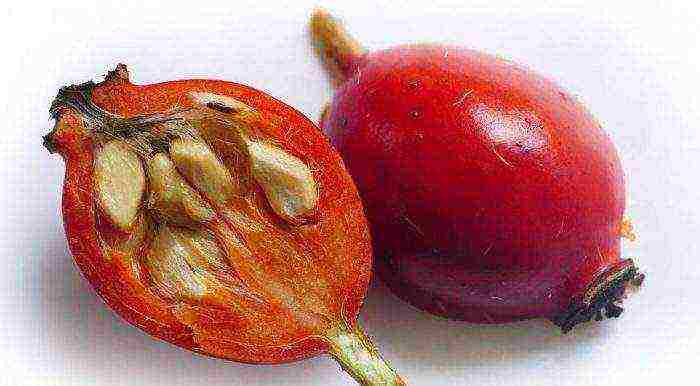
The seeds must be folded into a sieve and immersed for 30 minutes in a container filled with hydrogen peroxide. Thus, the disinfection of the seed is carried out, as well as the prevention of mold formation during further stratification. Soak cotton wool discs in hydrogen peroxide and place the seeds on top of them. Put the same moistened cotton pads on top of them. Each resulting "sandwich" should be placed in a separate polyethylene bag. Sign the date and variety name, and then place the seeds in a refrigerator container for storing vegetables. You need to arrange a systematic check. Moreover, if mold is found, then the seeds must be washed and again kept in hydrogen peroxide.The cotton wool is replaced with fresh one, and the seeds are placed back in the refrigerator. After 6-8 weeks, the seeds, which should have sprouts, should be planted in peat tablets or in separate small pots, and sprinkled on top of them with a layer of mulch, which should be taken as perlite, this will help to avoid the "black leg" disease. Provide the plants with at least 10 hours of daylight and timely watering as the substrate dries. If the plant develops normally, then 8 weeks after planting, they will have buds, and after 4-6 weeks the plant will bloom. Feeding can be done with a weak solution of complex fertilizer. In spring, they are planted in open soil, and then they are looked after, like adult roses.
Reproduction of a climbing rose by cuttings

Cutting is the easiest way of propagation, which gives good results. For cuttings, you can use both faded stems and flowering ones. They need to be cut from the second half of June to the first days of August. The lower oblique cut must be made directly under the kidney, while the angle of inclination of the cut is 45 degrees. The upper cut should be straight and as high as possible above the kidney. The handle must have at least 2 internodes. The lower leaves must be torn off, and the ones from above should be shortened by ½ part. It is planted to a centimeter depth in an earth mixture consisting of sand with earth, or in sand. Cover it on top with a glass jar or a cut plastic bottle. Move to a well-lit place protected from direct sunlight. Watering is carried out without removing the shelter. Treatment with a cuttings accelerating root growth agent can be useful only when the variety is distinguished by long rooting.
Reproduction by layering
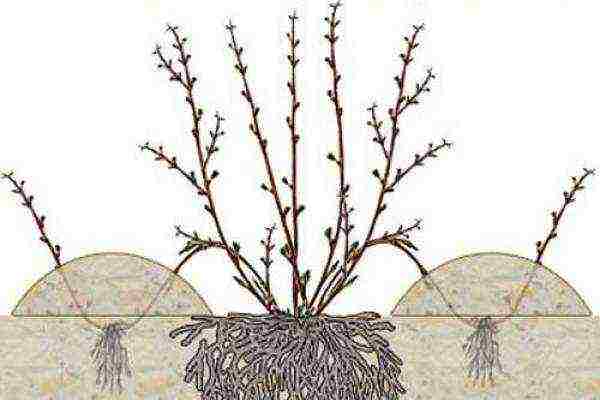
In spring, an incision is made in the shoot above the bud. Then it must be placed in the prepared groove, the depth and width of which should be from 10 to 15 centimeters. A layer of humus must first be poured onto the bottom of the groove and covered with soil from above. The shoot is fixed in several places. Then it is covered with soil so that the upper part rises above the soil surface. The layering needs systematic watering. After the onset of the next spring period, the layers should be cut off from the parent plant and planted in a new place.
Grafting climbing roses
Budding - grafting an eye of a cultivated rose on the rhizome of a rose hip. This must be done from the last July days to the last August days. Before being vaccinated, the rose hips must be well watered, after which an incision in the shape of the letter T must be made on the root collar of the stock. A peephole must be cut from the stem of a rose, along with part of the bark and wood. Then it is placed tightly in the prepared incision and the place is rewound very tightly with ocular film. Then it is necessary to huddle the rose hips so that the soil rises above the grafting site by at least 5 centimeters. After half a month, the bandage is slightly loosened, and the next spring it is removed altogether.
Features of care after flowering
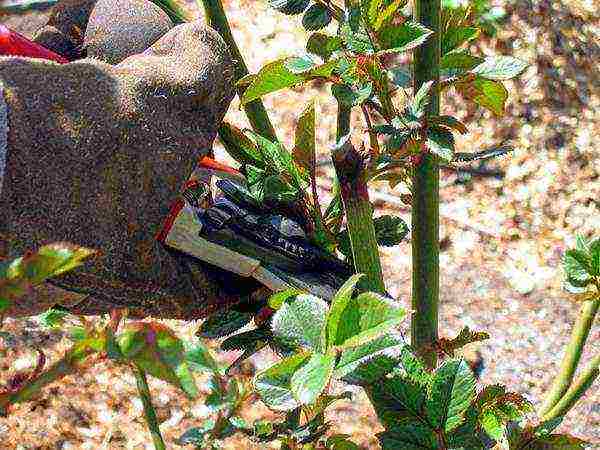
What to do when roses have faded
With the beginning of the autumn period, you should start preparing roses for the winter period. Since the last days of August, it is necessary to completely stop watering and loosening the land and start feeding potassium instead of nitrogen. The upper part of the unripe stems must be removed. Such roses must be covered for the winter, but first they are removed from the supporting structure and placed on the soil surface. It is very easy to lay a young plant on the ground. It is not easy to lay an adult specimen on the ground, and it can take up to 7 days. It should be remembered that at sub-zero temperatures, the shoots become fragile and can break.
How to cover climbing roses for the winter

You need to cover the plant when the air temperature drops below minus 5 degrees.This should not be done earlier, because the flowers must harden, and they can also begin to grow or grow (which is associated with a long stay under shelter without air). Shelter should be done in non-rainy, calm weather. From the removed shoots, you need to remove the leaves, cut off the damaged stems, tie the whips using a rope, and then carefully put them on the litter. To create it, you can use dry leaves or spruce branches. Do not place the plant on bare soil. Press or fix the plant on the soil surface, and cover it with dry leaves or grass, and you can also use spruce branches. The base of the bush must be sprinkled with soil or sand, and then cover the plant with lutrasil, polyethylene film, roofing felt or other material that is able not to get wet. A layer of air should remain between the plant and the shelter.
Winter care
With the onset of a thaw in winter, you need to raise the shelter for a very short time. Plants benefit from fresh air in winter. But you should not remove the leaves or spruce branches. When the real spring begins to come, the shelter must be removed, otherwise the plants may start to hurt. At the same time, the lapnik will save the roses from freezing.
Climbing rose varieties with photos and names
The most popular varieties are described below.
Rambler (small-flowered climbing roses)
Bobby James
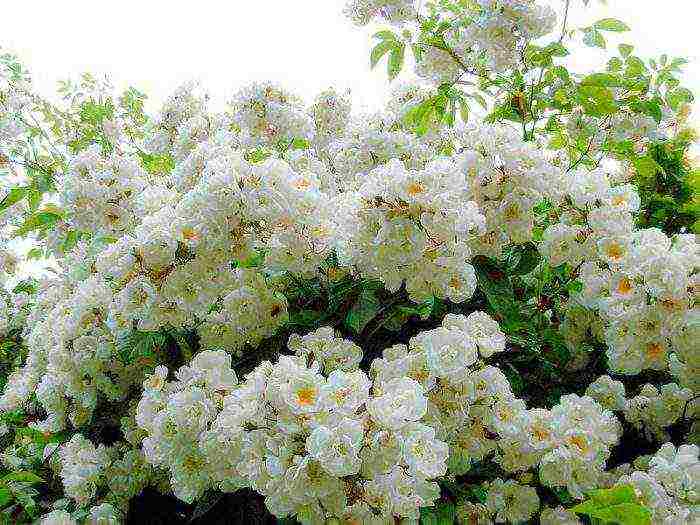
In height, such a vigorous variety can reach 800 cm while the crown is up to 300 cm wide. The rich green leaves are almost invisible due to the many creamy white flowers, the diameter of which is 4–5 centimeters. They smell like musk. A lot of free space and reliable support are needed. Not afraid of frost.
Ramblyn Rector

Light green leaf plates are decorated with five-meter lashes. Semi-double creamy flowers are rather small. They are 40 pieces in large inflorescences in the form of a brush. When exposed to the sun, they fade to a white color. Such a plant is also cultivated as a bush plant.
Super Excels

Bushes two meters high and wide are decorated with double flowers, painted in a rich crimson color, which are collected in racemose inflorescences. It blooms until the end of the summer period, but the bright color fades in the sun. It is frost-resistant and not susceptible to powdery mildew infection.
Climing and Climbing (large-flowered varieties)
Elf

The height of the erect, vigorous bush reaches 250 cm, and the width is 150 cm.The diameter of the double flowers is 14 centimeters. They are white with a greenish tint and smell like fruit. Bloom until the end of the summer period. Has resistance to disease.
Santana

The four-meter bush is decorated with dark green carved leaves and semi-double velvety large ones (diameter 8-10 centimeters). They have a deep red color. Not afraid of frost, resistant to diseases. It blooms several times per season.
Polka
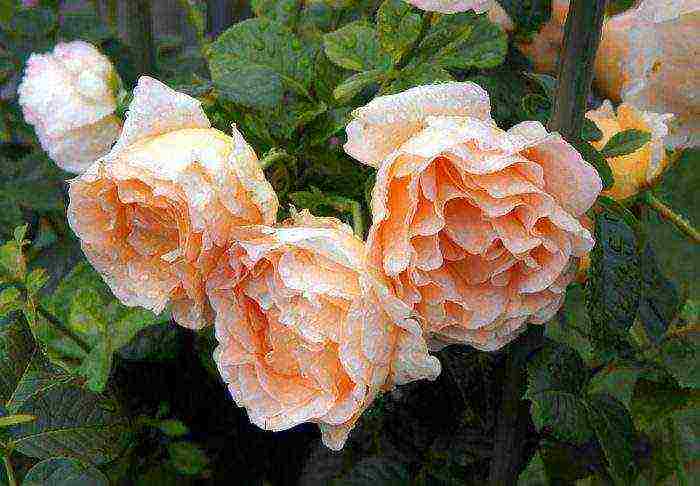
The height of the bush can exceed 200 centimeters. Glossy leaves are dark green in color, and large double (12 centimeters in diameter) flowers are apricot. During the season, flowering is observed 2 or 3 times. It is resistant to powdery mildew. Good shelter is needed for wintering.
Indigoletta

A vigorous three-meter bush has a one and a half meter diameter. The leaves are dense dark green. Terry lilac large (up to 10 centimeters in diameter) and fragrant flowers are part of the inflorescences. It grows rapidly and blooms several times per season. Resistant to disease.
Cordes hybrids (they are not separated into a separate group, but referred to as ramblers)
Lagoon

The fragrant tall plant has a diameter of 100 cm and a height of 300 cm. The racemose inflorescences consist of double large (up to 10 centimeters in diameter) flowers of a dark pink color. Flowering is observed 2 times per season. It is resistant to powdery mildew and black leg.
Golden Gate

The bush has many shoots, and its height is 350 centimeters.The racemose inflorescences consist of semi-double large (up to 10 centimeters in diameter) flowers, painted in a yellowish-golden color. They smell strongly of fruit. Flowering is observed twice per season.
Sympathy
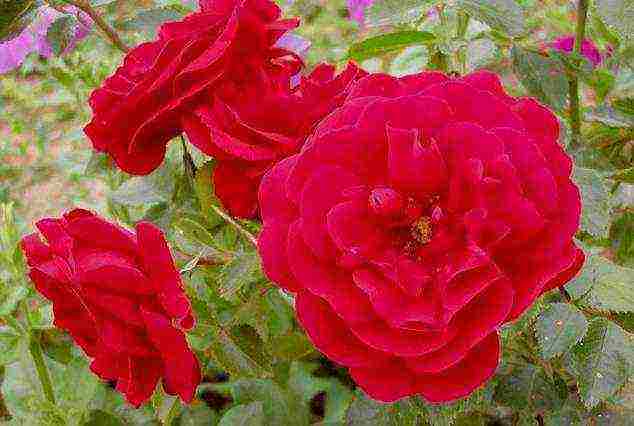
The height of a branchy, vigorous bush is up to 300 cm, and the width is up to 200 cm. Small inflorescences consist of rich red flowers. Flowering is observed several times per season, but the very first is the most abundant. He is not afraid of frost, bad weather and illness. Fast growing.
